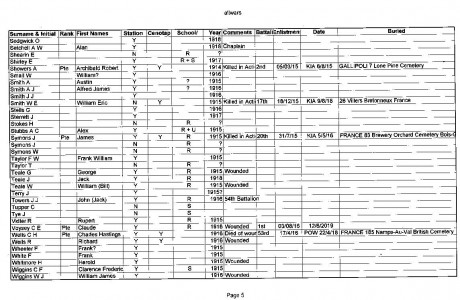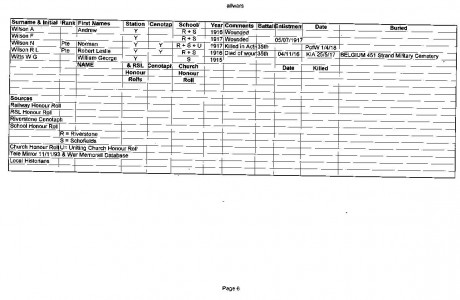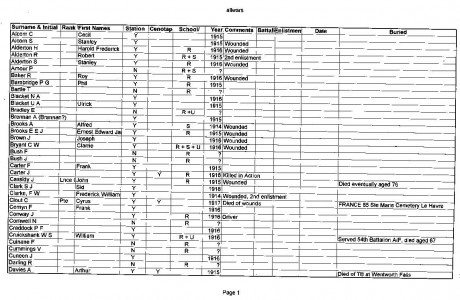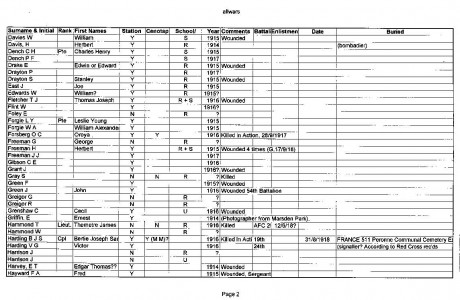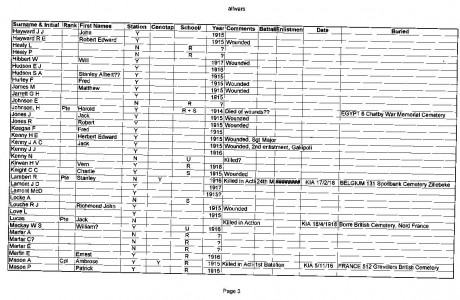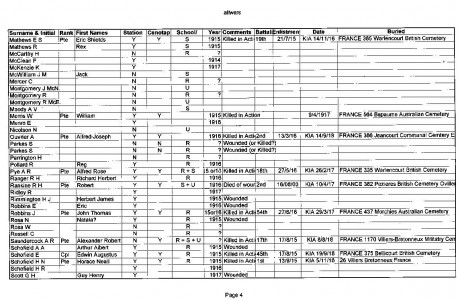William Arthur (Bill) Hughes 1890-1956
William Arthur Hughes known as Bill was born at Balmain, New South Wales, on the 6th. February 1890, and as a boy, delivered meat around the area on horseback for his father who owned the first butcher shop in Balmain.
Bill left school at an early age and went to work in a boot factory in Redfern where he learnt his trade as a bootmaker and repairer.
He opened his first shop in Glebe in the early 1920’s, moved to Leichhardt in 1929, then in 1932 moving again, he came to live in Riverstone with his wife and family of six children, two boys and four girls.
Living in the old slab house also known as “The White House” on the Western side of the Eastern Creek, Garfield Road, the family were flooded out many times. The Hanna family who also lived on that side of the creek owned this old house. The rent was Two Shillings (Twenty Cents) per week.
Employed by the Blacktown Council, Bill worked two days one week and three days the next week repairing relief workers boots, this was a type of working for the dole during the depression of the early 1930’s.
He opened his Riverstone shop in 1934 in the main street, Garfield Road, selling and repairing all footwear. Here there were two semi-detached shops built of mud bricks and owned by Mrs. Connie Moulds. Connie lived behind the shops and at the back of her house she had her trotting horse stables. Bill Hughes together with Dr. Brim Carroll and Wally Cornwell of Riverstone were silent partners with Laurie Moulds in the ownership of two trotters namely Derby Commerce and Machine Wood, they were trained and driven by Laurie Moulds, Connie’s son. Machine Wood won a race on the first night of night trotting following the War of 1939-1945. The old boot shop was a stopover for many who wanted a yam about trotters and the doings of the meat works. The shop was situated just above the Motor Service Station of W.R Nichols. (See the accompanying photograph) Mrs. Harris who also lived across the Eastern Creek had a “fish and chips” business in the second shop on the topside.
The eldest son Jim, worked with his father in the boot shop until 1940 when he joined The Royal Australian Air Force. Following Jim’s return after the War he wasn’t interested in working in the boot shop, so “Old Bill” as he was known by now, continued on alone until failing health caused his retirement in 1954. A quite family man liked and respected by all who knew him he passed away in 1956, aged 66 years.
Written by his daughter, Mrs. Anne M. Staib. March 2002
Riverstone School days
by Wendy Biddle
This speech was delivered by Wendy Biddle at the Riverstone Public School’s Official Consolidation Ceremony, Tuesday 5th November, 2002.
The Honourable John Aquilina, the Honourable Alan Cadman, the Principal and Staff, and, most importantly, the students of Riverstone Public School:
Forty-five years ago I had the honour of being the School Captain who, along with the Boy Captain, Neil Johnston, cut the ribbon to officially open the new building. The then minister, the Honourable R.J. Heffron, was most impressed with the school and surroundings, as it was one of the best in the district. The school had been open for approximately twelve months, but it did close for a short time, due to the presence of snakes and their danger to the students.
School was very different to what our children have today. Our 6th Grade Class had approximately 45 students who were disciplined and expected to toe the line in all aspects of their schooling. For the naughty kids there was the fear of the cane that was handed out in the little office at the rear of the 6th Grade classroom. We could all hear the whip of the cane and I’m sure that some of the teachers stood on a chair to get a little better swing, or that is what it sounded like when you were 11 years of age. The poor child would come out biting their lip so that none of the other children would call him or her a sissy. So you can see how lucky you are that you do not have to endure such pain.
Being a new school we no longer had to ring the bell as we had the hooter to summon us to class. To be the bell ringer was a very important position. We sat in the sun for school assembly, no shade, and on most days we had to practise our marching in team formation for the annual sports’ day which we all loved. We had a flagpole and sang “God Save the Queen” on a regular basis. We had no school canteen so we either brought lunch or rode our bikes home. You had a peanut butter sandwich and then came back again. I remember one day someone took my bike and I ran all the way home to tell my mother rather than tell the teachers.
School Excursions were a non-event. In fact I only remember going to one. That was to the theatre in Richmond to see something about Shakespeare. None of us could understand what it was about. No trips to Canberra or the snow then!
We learnt the 3 Rs – Reading, Writing and Arithmetic, read from the School Reader and we had a good overall base to carry us through to high school, which was another adventure. As many of you will do, some of the students went on to have very responsible positions in society.
In 1957 we were fortunate to have a tennis court on the grounds and the then Headmaster liked his garden, so we spent many hours pulling out weeds, rolling the court, or planting trees. One thing though, we didn’t have to mow the grass!
So, my final words to the students are – enjoy your schooldays, try very hard to achieve good results and life will be good to you. But, you have to put in your effort. You have an excellent education system to help you. I have been very honoured to attend today’s proceedings and it has brought back many memories of my own schooldays.
Thank you ever so much.
Riverstone Junior Rugby League Club History Prior to 1939
Originally compiled by Clarrie Neal February 2000.
Updated in June, 2009.
The following article was printed in Rugby League Week in July, 1977.
“Riverstone is a peaceful, sleepy little town lying at the foot of the famous Blue Mountains, 56 km west of Sydney. The Riverstone club was born during one of the most turbulent times in world history. As World War 1 broke out the Riverstone Butchers, as they became known, got off to a modest beginning, but no one knows exactly when the club was formed. The clubs records only go back to 1915 , but some claim the club was formed shortly before World War, others argue it was as early as 1911.”
The Windsor & Richmond Gazette has been continually printed since 1886 and has proved to be an excellent source of reference for resourcing the history of the Riverstone Football Club. It records that several attempts were made to form a Football Club in Riverstone in the years 1891 and 1894. As there were no organised competitions it is likely these matches would have been of a social nature against neighbouring towns. Also, it should be noted that as Rugby League was not officially played until 1908, it is likely these early efforts to form a club would probably have been to the Rugby Union code.
1891/5/6th – 20 members held a meeting in J. Irelands Riverstone Hotel to form a football club. Later that year it noted the ground was pegged out and goal posts erected.
1894/5/25th – A meeting was held to form a football club and 2 teams were selected to play a trial game. Football practice commenced on the newly formed ground in Mr. B. Richards paddock on Tuesday. It is interesting to note that each team comprises 13 players; which indicates the 13 a side game was being played unofficially many years before the official date of 1908.
Tom Woodfield’s team – W. Baxter, B. Bell, F. Cornwell, H. Smith, J. Rosa, Jersey, J. Brown, W. Hodge, H. Campbell, W. Warden, H. Parrington, F. Marlin, C. Miles.
Arthur Cornwell’s team – J. Little, C. Stanford, C. Drayton, G. Varidel, F. Rosa, W. Small, H.Sunley, M. Parmenter, W. Henley, J. Melville, W. Forbes, H. Spinks, J. Viney.
Umpires – R. Toomey, H. Spinks, W. J. East.
In 1897, attempts were made to form a football club but apart from a couple of trial games played they were unsuccessful.
The W. & R. Gazette on the 28th April 1900 noted that 22 members held a meeting to form the Riverstone Football Club and the following committee was elected:
Patron – Mr. B. Richards, President – J. Quinn, Vice Presidents – B.Hall, J.Cragg, E. Bradley, F. Mette, C. Davis, L.J. Darling, A. Bambridge. Treasurer – A. Jarrett.
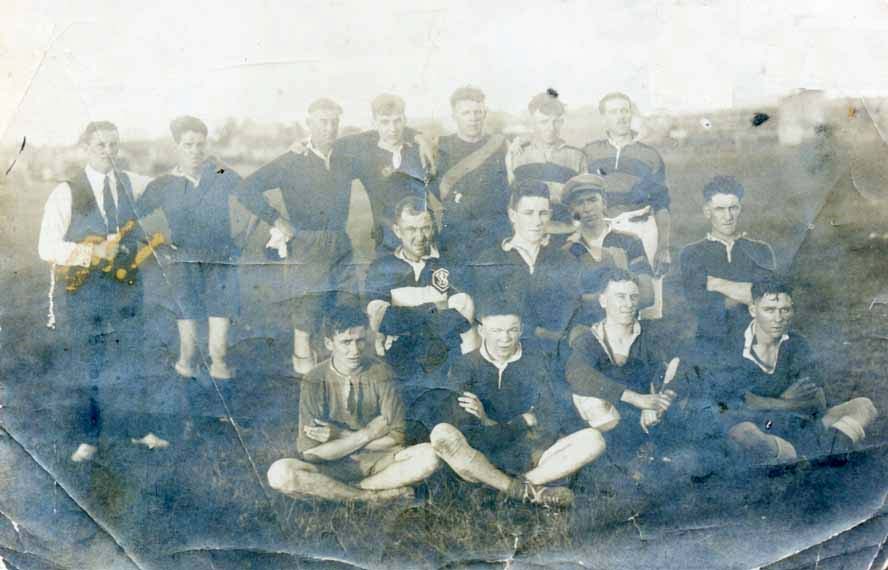
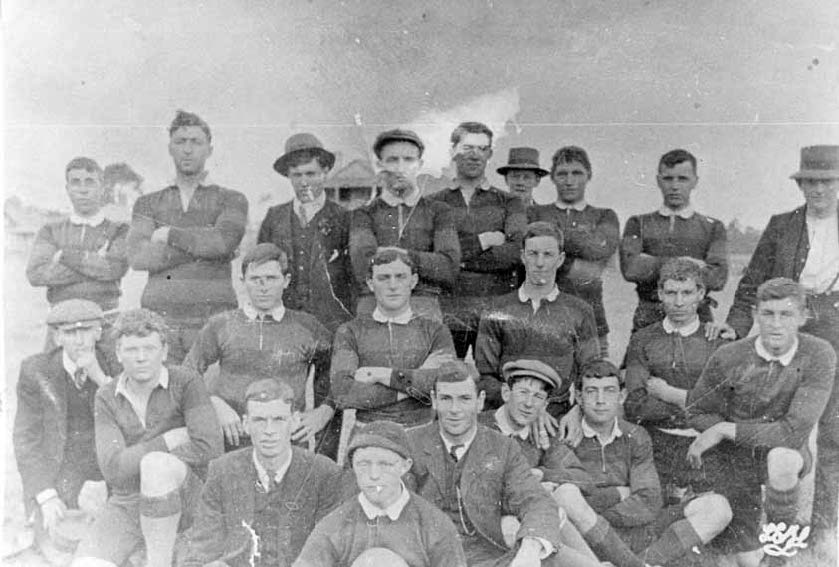
It was decided the club colours would be Blue, Black and Gold in 2-inch bars. After a promising start no match results appeared in the Gazette so it is likely that the club failed to survive.
It was 1907 before match results again appeared in the Gazette when, Riverstone played 2 social games against Windsor and another against Glebe Island.
The Gazette reported a greater interest in 1910 when the Riverstone Football Club was formed and several matches were played against teams from Auburn, Windsor, Glebe Island and Seven Hills. However, there is no record of these games being part of an official competition.
The Gazette noted the results of several of these matches:
1910/5/21 – Riverstone Football Club were defeated by Windsor 15 – 0 at Riverstone.
1910/5/28 – Riverstone defeated Windsor Athletic Club 11 – 3.
1910/6/11 – Riverstone defeated a team from Auburn 8 – 3, the best player was S. Drayton.
1910/6/25 – Riverstone defeated a combined Windsor Rovers/Athletic team 11 – 3 at Windsor. The best players were H. Davis, C. Davis, & T. Woolfe.
After this match, Mr. Pomfret, a great supporter of the Riverstone club invited the players to his home to celebrate. In a speech he said he felt proud to be a member of the Riverstone Football Club.
1910/7/2 – The Gazette reported- “A great match is to take place in Riverstone this Saturday between the Windsor Football Club and the best blood of Riverstone. Never in the history of Riverstone has such excitement prevailed in football circles. Old timers have their sons representing them, men such as Mills, the famous three-quarter from the Surrey club, and Stan Wall, the fast sprinter, will play for Windsor. In the evening a banquet will be tendered to the victorious team by the vanquished side. Ald. J Cragg will represent Windsor at the function, and Mr W Weymark will preside at the gathering for Riverstone. On Wednesday evening a presentation will be tendered to Joe Brown for the able manner he has coached the Riverstone Club, thus securing victories against older and more experienced teams.
Ald. J M Cragg will be asked to make the presentation on behalf of the Riverstone folk, and all true sportsmen are invited to attend the club rooms of the Riverstone Hotel next Wednesday at 3-30 pm.”
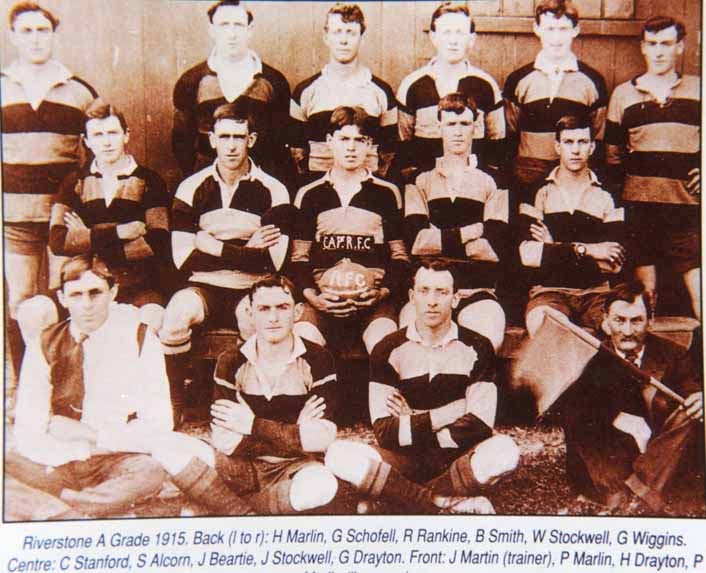
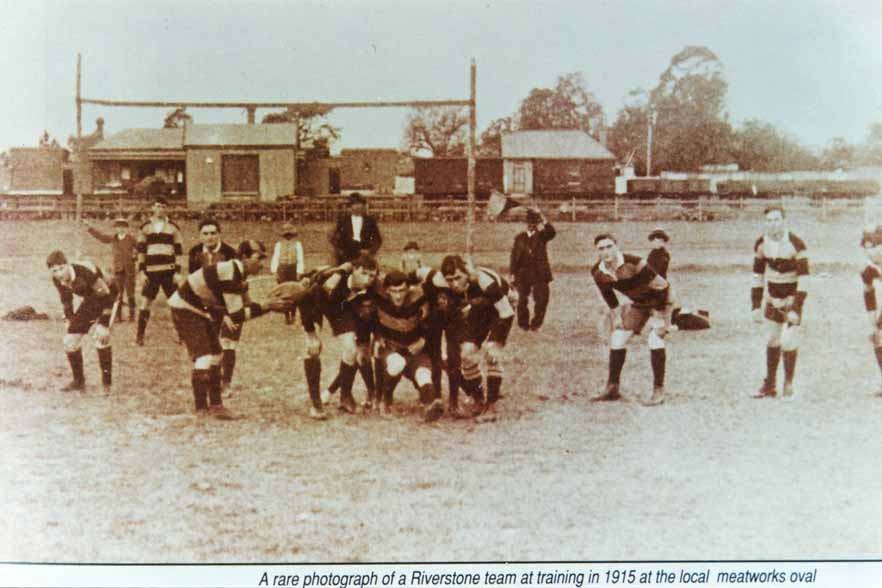
1910/7/9 – The match was won by Windsor, easily defeating Riverstone 17 – 0. In speeches made at the dinner after the game, Mr Weymark, the Riverstone Secretary congratulated the Windsor team on their win. Stan Wall spoke for the winners, hoping Rivo would play a return match at Windsor for a turkey dinner. (as supposedly arranged this time), and not corned beef. The referee Mr O’Callaghan then instructed both teams, and said Riverstone players had much to learn.
These comments on the dinner by Stan Wall sparked a war of words between the 2 correspondents over the coming weeks, with several letters to the editor.
1910/7/16 – The Riverstone secretary responded to the Windsor claims of a turkey dinner, stating it was never a turkey dinner, it was for a roast dinner at a cost of 1 shilling, the vanquished players having to pay 2 shillings each. He then commented on the Windsor boys behaving in a rowdy fashion, breaking a table in halves, and acting like a lot of goats. He further commented the dinner at Riverstone was better than the bread and cheese they had received on their visit to Windsor.
1910/7/23 – The Windsor correspondent replied but remained anonymous under the name “Who’s this”. He criticised the dinner again and then made several comments on the behaviour of the Riverstone boys, and asked why his report could be false when Windsor won so easily.
1910/7/30 – W. Weymark this time asks who would expect a turkey dinner for a shilling, and offers 5 pounds to Windsor Hospital if it can be proved that such an agreement existed. He then invited ‘Who’s this’ to come out into the open.
This letter marked the end of the war between the football correspondents.
1910/10/3 – “The Riverstone Football Club will hold their annual picnic at an early date, and in the evening a dance will be held. Mr. Harry Smith will take the opportunity by presenting the best player during the season with a handsome trophy, which is now on view at the Riverstone Hotel. Thanks are due to Mr. Smith.”
However the interest shown in 1910 was short lived as in the following years, 1911-12 -13, only an occasional social match was played.
1914 saw a growing interest in the new code of Rugby League and several matches were played. The Gazette noted that several matches were played against teams from Windsor, Richmond, and North Parramatta.
1914/8/28 In a game played at Riverstone, the home team were leading Windsor by 12 points to 4 when the game was called off. The Gazette noted –
“The football ground at Riverstone on Saturday was evidently converted into a slaughter yard. A Windsor District Club team went down to play Riverstone and the game had proceeded right enough until the scores were Riverstone 12 and Windsor 4. Then the football field was converted into a battlefield. We are told 30 to 40 persons were engaging in a free fight. Arms and legs were flying indiscriminately in the air, and any face or body within reach was hit and kicked ad lib. One would have thought the German Army had invaded the town.”
This interest shown in 1914 continued on to 1915 and the Riverstone Club for the first time entered a team in the Western Districts Junior League competition. The Gazette noted –
1915/4/16 – The Football Club was formed and members were training and marking out the playing field.
1915/5/21 – Their first competition match saw Riverstone defeat Blacktown 2-0.
Riverstone then played teams from North Parramatta, Lidcombe, and Springwood, and in July playing at North Parramatta they were defeated 29 – 0. It was noted the boys still came home happy and this was the last reference to the football club for the year. There is no evidence of competition matches being played in 1916.
The club was formed again in April, 1917 and a team was entered in the Western Districts competition with teams from Liverpool, Fairfield, Merrylands, Parramatta, Auburn, Blacktown, Richmond, Emu Plains, Windsor and Riverstone. With rail the only available form of transport, and a poor service on the Richmond Line, getting the teams to their away games was always a problem.
With so many young men at the war front it appears many clubs were struggling to field their teams. On 5th May 1917 the Gazette noted – “ Owing to many of the former members of the Riverstone Football Club being killed at the war during the last few months, the club intends to call a meeting to consider the advisability of abandoning all their matches this season.”
However the club must have decided to continue playing with the Gazette regularly publishing the results and noting on 29th May that Riverstone was in second place on the ladder. The Gazette on 6th July noted that the footballers were helping Pte. J. Fell on his poultry farm after he had returned home wounded from the war. In August the club was fined 7 shillings and sixpence when one of its players advised the referee “he was not refereeing in a fair way”
The competition was in more trouble with the great rail strike that prevented the teams from travelling, Riverstone receiving forfeits from Fairfield, Auburn and Blacktown. The Gazette 24th August reported the competition was abandoned until after the rail strike ended. This was the last time Rugby League was mentioned for the 1917 season and the Gazette makes no mention of competition matches being played in the War years of
1918 or 1919.
The Western Districts Junior R. L. competition re-commenced in 1920 with teams from Parramatta North, Parramatta Endeavours, Granville, Lidcombe, Auburn, Windsor, Wentworthville, Blacktown, St. Marys, Emu Plains, Penrith and Riverstone. The ‘A’ grade was open and the ‘B’ grade under 9 stone 7lbs.
Riverstone entered a team in each grade, with the ‘A’ grade withdrawing from the comp in mid July. Many clubs had problems getting teams to their ‘away’ games, there were no motor vehicles and train travel was the only option. The poor service on the Richmond Line to Riverstone did not help. The ‘B’ grade completed the comp, winning 3 of the 8 games played.
1921 promised to be a much better year for the club with C. Whitehead – Secretary, W. J. East – Patron, D. Doolan – President, and W. Wiggins – Treasurer. The club registered their new colours – black and gold and entered teams in both grades.
The Gazette was now giving a better coverage of the Rugby League code with results of all games and the points table for both grades. It also noted that some teams could now travel by motor lorry. Both teams finished the comp in the bottom half of the ladder, with C. Whitehead being their best player. The Gazette noted the ‘B’ grade game against Blacktown was played in 30-minute halves to allow the visitors the time to catch their train home.
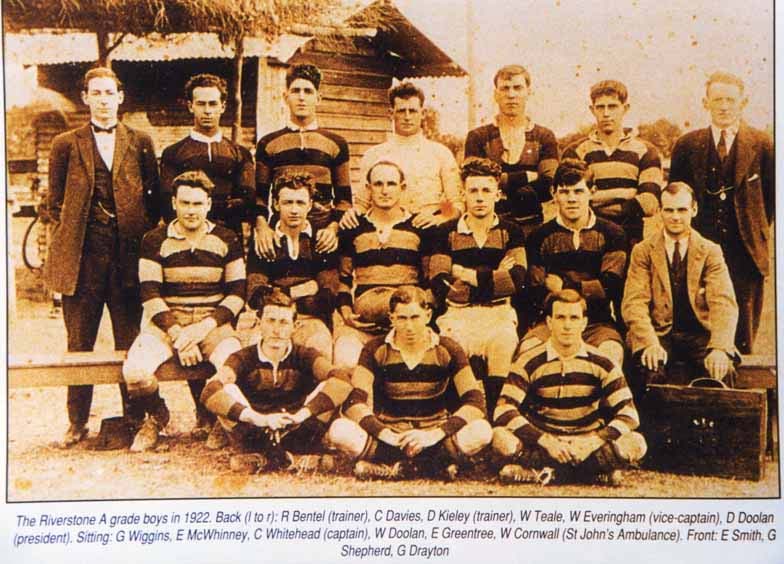
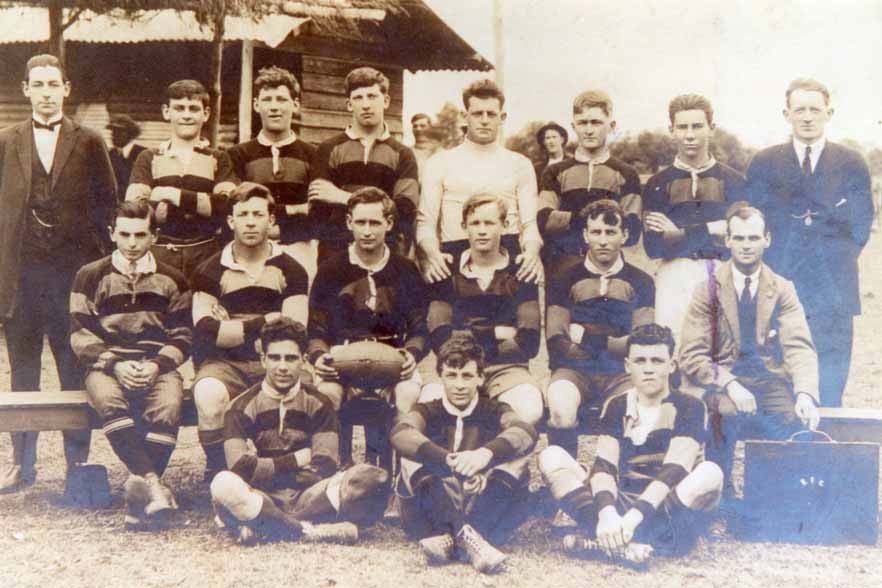
Back row: 1. R Bentel (Trainer) 2. N Rosa 3. S. Mangold 4. S. Alcorn 5. D. Keily (Trainer) 6. J. L. Gilbert 7. R Ward 8. D. Doolan (President)
Centre row: 1. A. Arnott 2. P. Drayton 3. W. Turner (Captain) 4. H. Drake 5. J. Chalker 6. W. Cornwell (St Johns Amb.) Front row: 1. S Unwin 2. G. Rosa 3. D. Rosa
Additional teams playing in the 1922 competition included Parramatta East, Clyde, Richmond and Baulkham Hills, with Riverstone fielding a vastly improved team. The Gazette noted on 25th May – “ —- the magnificent victory by Riverstone over last years premiers Parramatta Norths; a team that during the whole of last season and up to last Saturday had remained unbeaten.”
The Western Districts League sometimes had problems getting referees; when the referee failed to show for the Rivo v. Baulkham Hills match the opposing team captains agreed that local officials could referee their games. Les Clarke (Rivo) was the ‘A’ grade referee and the ‘B’ grade game against Windsor was refereed by George Wiggins (Rivo) in the first half, and the second half by Bill Maisey from Windsor.
The Gazette also reported on a visiting Maori team playing in Sydney, with the curtain raiser game being played between Riverstone Vs Paddington. It also noted several Riverstone boys were playing in the President Cup trials at the time.
The Riverstone club held a Masquerade Ball and presentation night in November and presentations were made to – W. Everingham – the best player, Claude Schofield – the best back, Bill Doolan – the best forward, Dennis Rosa – the most improved.
The Gazette on the 30th March, 1923 published a front page report on the Windsor clubs Annual General Meeting, with the headings “Record Season Reviewed” and “Amalgamation With Riverstone.” This heading was somewhat surprising when one considers the previous encounters between these 2 clubs. The delegates representing Riverstone at this meeting were Col Whitehead, Dan Doolan, A. Keegan, P. Gilbert, W. Hanna, and W. Everingham.
The Riverstone Club had raised the matter the previous year of forming our own group of teams from the Blacktown, Penrith, and Richmond districts, but it failed to gain any support. At this Windsor meeting Col Whitehead spoke of the local teams labouring under the many disadvantages such as sparsity of population, and of the difficulties of getting good coaches to tutor the players. He said teams would have to unite to be a force against the strength of the teams from the Parramatta district.
The meeting actually agreed to the proposal but for one reason or another it never eventuated and that was the only time the term ‘amalgamation’ was ever mentioned. In the 1923 competition Riverstone entered an ‘A’ team and ‘C’ team, with Windsor entering a ‘B’ team and a ‘C’ team.
The Riverstone ‘A’ grade played 16 games, winning 8 and 1 drawn game. The C’ grade team finished at the bottom of the table. At the clubs end of year Presentation Ball gold medals were awarded to-Frank Parkinson – most improved player. Les Clarke – most consistent player. Col Whitehead – the best all round player.
In 1924 and 1925, it appears Riverstone did not field teams in the W D R L competition but there was a ‘B’ grade team from Schofields. The competitions in these years were subject to a large number of protests from the various clubs.
1926 – A poorly organised competition saw the only team Riverstone entered (‘B’ grade) withdraw from the competition in July. Very few of the clubs had access to the telephone and communications between the clubs was poor. A lot of games were won or lost by forfeit.
The Gazette in 1927 gave scant coverage to the Riverstone games and it appears the club fielded a ‘C’ grade team only. However, on the 16/9/1927 the Gazette noted – Riverstone Football Club are on the verge of claiming a most successful season. Invariably they left the field victorious, and were supported by a most energetic committee.
It appears that in each grade there were 2 competitions played during the season, the main competition was the Premiership and it was first past the post, there were no semifinals or finals. Later in the season a Knock-out competition began, open to all teams with the semi-finals and finals played the week-ends after the Premiership had concluded
In the ‘C’ grade grand final at Granville Riverstone defeated Westmead Boys Home 5 points to 2. It was 2 all at full time and 20 minutes extra time was ordered when R. Rosa scored for Riverstone. A. Brookes (scrum half) and A. Britton (full back) proved the outstanding players of the afternoon. This was the only match reported the Gazette reported on for the entire 1927 season, so it is likely this was a Knock-out competition.
1928 saw the Gazette giving good publicity to cricket and tennis, both sports being very popular throughout the Hawkesbury, but very little attention to Rugby League. There were no game results or point score tables published throughout the season.
On the 2nd March it noted 40 members attended the first Riverstone club meeting for the year, but Riverstone was rarely mentioned after that, until the end of the year when it noted the Riverstone ‘B’ grade team finished well up in the competition. The Gazette 21/9/1928 reported Blacktown won the ‘A’ grade premiership and Riverstone won the “A” grade Knock-out Cup final defeating Blacktown 4 – 3 in an entertaining final. Their best players were D. McCarthy, C. Schofield and A. Brookes.
At the presentation held on the 12th April 1929, Secretary Bill Doolan thanked the Riverstone Meat Co for providing the playing field and for their assistance with the pavilion.
With the coming of the motor car and truck, often the football teams travelled to their away games on the back of a table top truck, some times having problems, as the Gazette on the 7th June 1929 noted – “18 members of the Baulkham Hills football team returning home from their match against Richmond were injured when their truck was involved in an accident and ran down an embankment. Parramatta ambulance attended and after treating the injured, 2 players were conveyed to Parramatta Hospital.”
10/5/1929 – The Gazette reported a Granville District team of 13 players comprised 10 players from the Riverstone club. The only other reference to Riverstone was when it played Windsor, Riverstone won the ‘B’ grade and Windsor won the ‘D’ grade. Richmond won both the A grade competitions (20/12/1929.
The Gazette 20/5/1930 noted Riverstone defeated Penrith, the best players being Fred Teale, Mr. Allen, and Mr. Schofield. The same report noted Riverstone the next day played the Western Districts Presidents Cup team in a trial match and were defeated 13 points to 8. Fred Teale scored all Riverstone’s points with 2 tries and a goal.
Gazette 29th August, 1930 Riverstone v Toongabbie “Rafferty Rules were the order at the conclusion of the football match played at the latter’s home ground on Saturday afternoon. The home team won the football match by 10 points to 8 , with Fred Teale scoring 2 tries for the losers, but the subsequent battle resulted in Riverstone emerging Victorious ! Fists and feet flew in all directions, so much so that anyone one could have a whack. During the onslaught, it is reported that Riverstone’s popular mascot was rendered ‘hors de combat’ by a blow below the belt!
It was Riverstone’s first defeat on the football field, but they will win the match on a protest. The Gazette 7/ 11 / 1930 congratulated Riverstone on winning the A grade Premiership.
1931 saw Riverstone enter an ‘A’ grade team and a points score table at the 20th June showed Riverstone 3 points behind the leader with a game in hand. The ‘A’ grade points table was published courtesy of a Mr W Kerr of Blacktown; Blacktown 12 points, Toongabbie 10, Penrith 10, Riverstone 9, Richmond 4, Windsor 4, Wenty 2, Wallacia 1.
24 / 7/ 1931 The Gazette reported the Age Limit Rule was becoming a farce — “A” grade football in the country will die out if the ban against a player over the age of 24 is not cut out.
5 /6 / 1931 – R Douglass and F Teale were selected in the WDJRL Presidents Cup team to play the curtain raiser to the NSW – Queensland clash. The Riverstone team to play Springwood next week was also shown, a very rare occasion for the Riverstone team to be named before the game.
The team selected was – A. Britton, K. McDonald, M. Smith, J. Smith, K. Sutton, S. Cummins, L. Locke Capt, C. Douglass. F. Teale, R. Allen, E. Allen, B. Allen, J. Fitzgerald, A. Groves, S. Lane. The truck was to depart Conways shop at 11- am 14th July 1931- The Gazette on the 14th July reported that Riverstone was leading the competition. Fred Teale appeared to be their best player and had been selected in the Western Districts President Cup team. The Gazette reported on protests that were regularly entered by the clubs and the Riverstone Club had recently won several protests. The Gazette was now giving a much better coverage of the Rugby league competition, and other related issues.
7 / 8/ 1931 it reported Windsor had played a social game on their home ground, McQuade Park, the previous Sunday against a team from Pyrmont, their players and supporters arriving in a convoy of 8 tabletop lorries. After the game the police arrived and took the names of all the players, both locals and the visitors, with a view to prosecution for playing sport on the Sabbath.
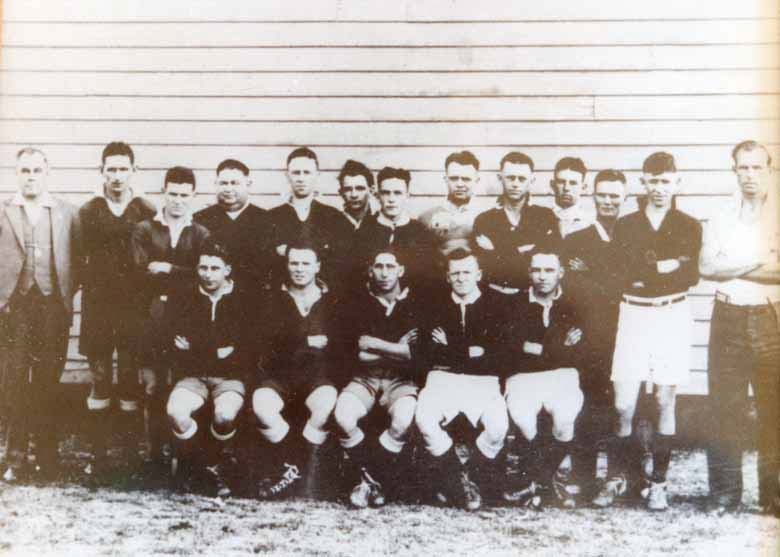
Back Row: 1. Manager M. Johnston 2. Les Britton 3. B. Allen 4. Ben Hibbert 5. Bernie Rosa 6. 7. C. McDonald 8. ‘Bull’ Greentree 9. 10. 11. Ron Allen 12. Jack Freeman 13. Harry Davis
Front row: 1. Tom Johnston 2. Fred Teale ? 3. ‘Tiger’ Locke 4. Sam Lane 5. J. Smith
The Gazette on the 14 / 8 / 1931 on a front page report under the headings – “Windsor Council refuses to take action against footballers “”Sunday Sport is an Important Issue”. The end of the article noted that the Police had dropped all charges.
Also on the same date it noted Riverstone won several protests against other clubs and were now leading the competition by 3 points and have the premiership safely in their keeping 21 / 8 /1931 It noted a WDJRL district team comprising 6 players from the Riverstone club had defeated Western Suburbs 19 -5.
11 /9/1931 Riverstone defeated Toongabbie 11 points to 10 in a semi-final of the Knock-out competition. The following week they defeated Richmond 10 points to 0 in the final thus achieving both championships, the Premiership and the Cup. The club intended to hold a Victory celebration in the Olympia theatre.
In the 1932 competition, Riverstone again fielded a strong team and 4 players were selected in the WDJRL Presidents Cup team – F. Teale, Curly Douglas, Mick Smith and R Lane.
It was another good year for Riverstone with the club winning both the A grade premiership and the Knock-out Cup again. The Gazette 19th August reported Riverstone had won the Premiership when they defeated Penrith 11- 0 at Riverstone, watched by a crowd of almost 1,000 spectators.
Riverstone won the Knock-out cup by defeating Wentworthville 16-3 in the semi-final and went on to defeat Blacktown in the final. The Gazette reported the final as the hardest and fastest game of the season, the score was 8 all at full time, and after 20 minutes extra time, Riverstone emerged the victors 11 – 8. Both teams finished with 11 players, Riverstone lost Curly Douglas when he was carried off, and Arthur Britton was sent off.
In other games after the competition ended, Riverstone issued a challenge to Gosford for the Cusick – Speers Cup. The Gosford paper reported “a spectacular game that thrilled the crowd ended in a 13 all draw”. Riverstone also entered a team in the Lackersteen Cup , but were beaten 12 – nil by Penrith.
Riverstone commenced the 1933 competition well but faded towards the end of the competition. On the 19th May, with a crowd of 700 watching, Blacktown defeated Riverstone 11 – 3. After the game several spectators were involved in a brawl.
The only other references to the club this year was to individuals – 14th July, ‘Tiger’ Locke was called up to play 3rd grade with Western Suburbs, and ‘Mick’ Smith was called up on the 21st July. On the 15th September, the Gazette reported ‘Tiger’ Locke had been granted a clearance to play with Orange, where he was now employed.
1934 saw the Gazette give a better coverage of the game of Rugby League, noting on the 25/5/1934 that Riverstone had defeated Blacktown 10 – nil.
The following week the Riverstone club was granted permission by the WDJRL to take a team to play Orange on the Kings Birthday week-end. Domiciled now in that country town along with ‘Tiger’ Locke were Eric Allen and ‘Curly’ Douglass’. On the 8th June,1934, the Gazette reported the Riverstone team at Orange won 2 out the 3 games played, and enjoyed some wonderful country hospitality.
The points table showed Riverstone A grade leading the competition with 8 points , followed by Parramatta, Richmond & Penrith on 6, Blacktown, Pendle Hill, & Toongabbie on 2. The Gazette 15th June reported the A grade competition was becoming farcical with teams pulling out. 27th July 1934 the Gazette reported Riverstone won the A grade competition on Saturday when they defeated Blacktown 13 points to 9.
7th September 1934, the Gazette reported Riverstone met Blacktown in a Rugby League challenge match at Blacktown showground on the 25th August before a large and enthusiastic gathering of spectators. The contest carried a stake of $20 a side, and after a fairly even struggle, Riverstone proved to be the victors again by 13 points to 8.
The 1935 competition commenced with 6 teams in A grade – Quakers Hill, Parramatta, Windsor, Riverstone, Penrith and Richmond. Riverstone and Parramatta disputed the lead early in the year, but on the 5th July the Gazette noted their were only 3 teams left in the A grade – Parramatta, Windsor and Riverstone. The Grand Final was played on the 2nd August, with Parramatta defeating Riverstone 3 points to 2, at Blacktown.
It is not certain what the Riverstone club’s original colours were and it appears over the years several changes have been made. Early photos, including one dated 1920, indicate a variety of guernseys were worn, but this may have been at a trial game. The black and gold bands on their guernseys are clearly visible in the 1 9 15 and 1922 photos. However the photos taken in 1928 show an all maroon guernsey. It is believed that the all maroon was the colour until the1 930’s when it became a maroon guernsey with a gold V. The gold V remained until 1955 when it was replaced with a narrow gold band on the maroon.
Riverstone Rugby League Club has seen many changes in their 90 year history and have played in three district competitions. From its inception in 191 5 until 1946 it played in the Western Districts Junior League (under the control of Western Suburbs), from 1947 till 1966 it played in the Parramatta District Junior League, and has played in the Penrith District Junior League since 1967.
The Butchers first 2 playing fields were cow paddocks, both located on the meat works property. It is believed their first field was at the rear of the houses in ‘Butcher’s Row.’ Later they moved to another paddock, 200 metres down the road and opposite the railway station. The club used voluntary labour to build a pavilion on this ground, which later became the site of the Riverstone Showground.
Life in Riverstone has always revolved around the Riverstone Meat Co. and over the years a large majority of the footballer players worked there – hence the club being known as the “Butchers”.
Frank Crowley,(who was better known as Toodles), wrote in an article in the Penrith book “Bound For Glory” recalling the old pavilion being built. He also recalled Riverstone’s Mr. Rugby League, Basil Andrews, building the showers at the end, and the copper boiler that was used to supply the hot water (sometimes).
This pavilion was moved to the site of the present ground in the 1940’s by placing it on log rollers and a truck owned by Dick Stacey was used to drag it across Garfield Rd. to the site of the present oval. The stand remained there until it was reduced to ashes one bonfire night.
Frank recalled the club in the 40’s attracting crowds of 300 -400 to their home games, a very good crowd for those days, with the club being able to buy new guernseys, to replace the old ones that had become tattered and faded. Over the years Riverstone was very fortunate to have the services of committee men of the calibre of Frank Crowley, Basil Andrews and Charlie Harris, all of whom gave a lifetime of service to Rugby League.
Frank Crowley, after playing football, served as a committeeman for many years and later became a referee. As a reward for all these years of service to Rugby League Frank was made a Life Member of the Riverstone Club. He was also made a Life Member of both the Parramatta and Penrith District Junior Rugby Leagues for his efforts to those clubs.
Basil Andrews was a clerk at the meat works and the club secretary who was born about the same time the club was founded. Basil was considered to be the “father of the club”; such was his love for the ‘Butchers’ that while fighting with the AIF in New Guinea he sent money back to Australia to buy a shield for which clubs from the Western Suburbs could compete. He spent much of his time working for the Riverstone club and was rewarded with Life Membership.
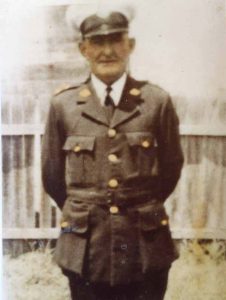
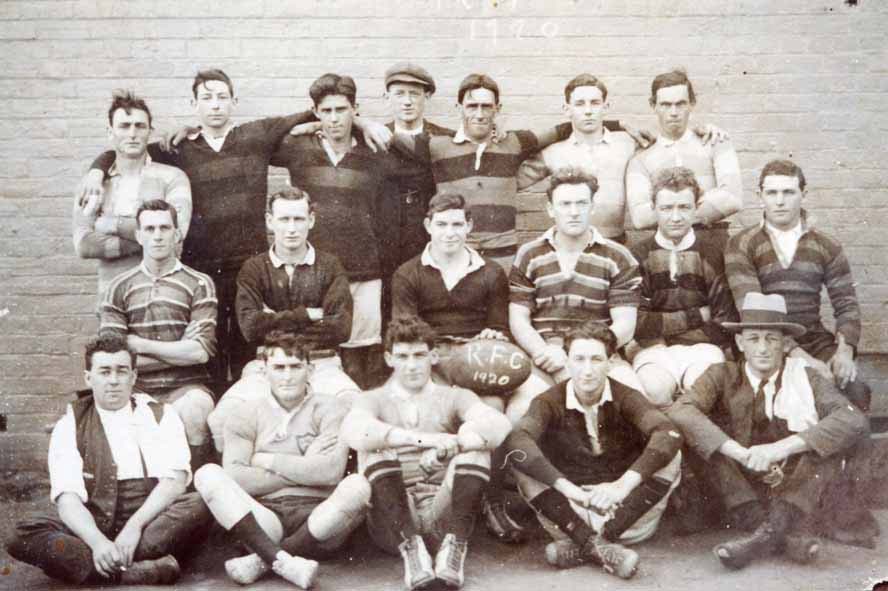
Basil Andrews was also made a Life Member of the Parramatta Junior League and later became the Penrith Junior Leagues first Life Member; a just reward for the many hours he spent working for the Junior Leagues in the district. Charlie Harris, after many years service to the Riverstone Club and to the Penrith J.R.L. was another who rewarded with Life Membership of both organisations.
Wally Brown was another interesting Riverstone personality who played for the club in the 1940’s. Wally owned a pig farm at Rouse Hill and always ran to training and back home again in his army boots, 7 km each way.
One of the Butcher’s most colourful supporter was a Mrs. Britton, an elderly lady who always sat in the same spot on the sidelines at the Riverstone games. Mrs. Britton was regarded as a health hazard to the opposition players. She often used her umbrella to trip players running up the sideline and several times clobbered them with the brolly.
The history of Riverstone Rugby league Football club is continued in the post 1945 history document.
Riverstone Junior Rugby League Club History Post 1945
by Clarrie Neal
The 1947 Riverstone A Reserve grade side had an outstanding record when they won the premiership that year. They scored 301 points and conceded only 31 that season as they swept all before them. Captain Coach of this team was Noel (Butch) Drayton, one of 4 Drayton boys that played that year. The others were George, Alan and Lennie.
In 1952 there were so few players in the area that Riverstone was forced to unite with Richmond; they met with only mediocre success that year and in 1953 their coach was Bernie Becke. Things were much better when in 1954 Riverstone were able to secure the services of Freddy Brown as a playing coach.
Freddy was a top class player who had spent a few years playing with the Balmain & St. George lst grade sides in the Sydney competition. His guile and leadership led the team to the semi-finals that year and formed the basis for their success in the years to come.
The following year 1955, the team coached by Jack Mundey won the 1st grade Premiership, defeating Richmond in spectacular fashion. After trailing 1 1-0 at half-time and down 14 -0 midway through the 2nd half, they produced a whirlwind finish scoring 5 tries and 2 goals to win 19 -14.
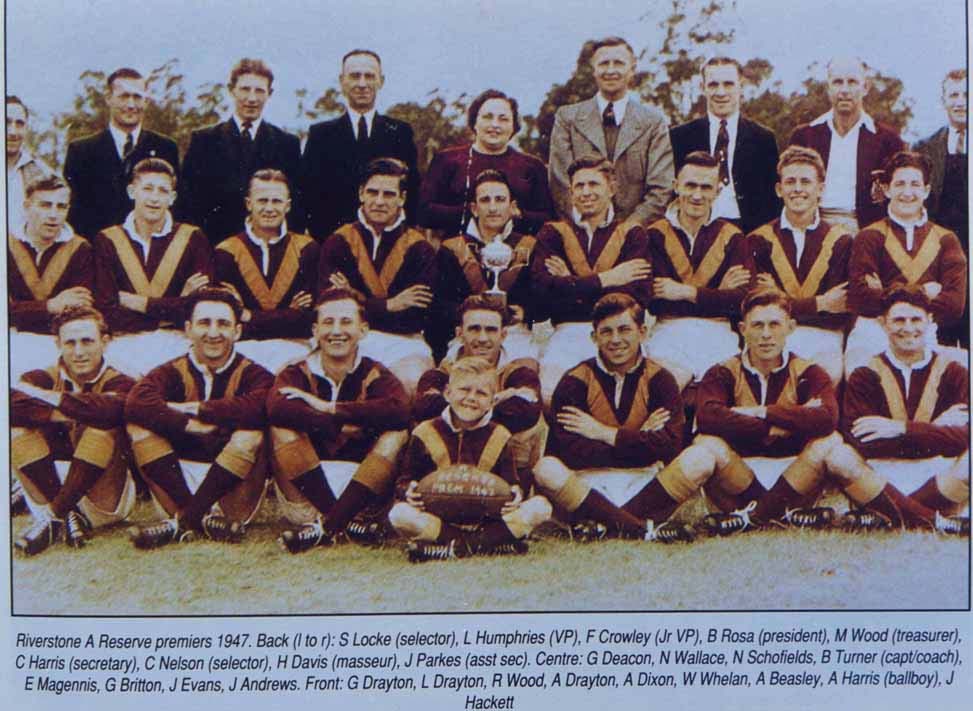
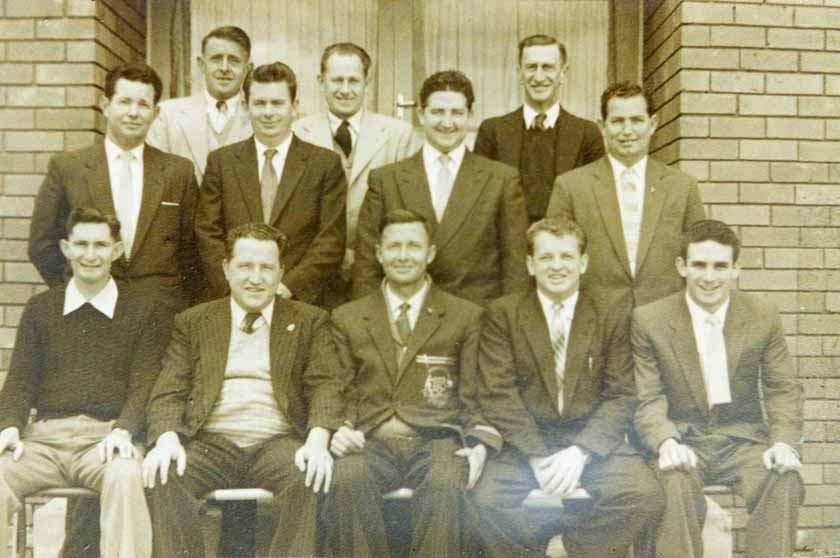
Back row: Fred Russell, George Johnston, Charlie Smith Middle row: Noel Woods, Jimmy Sandilands, Jimmy Andrews Terry Woods
Front row: ‘Daisy” Fussell, Basil Andrews, Charlie Harris Brian Tozer, Jimmy Robbins
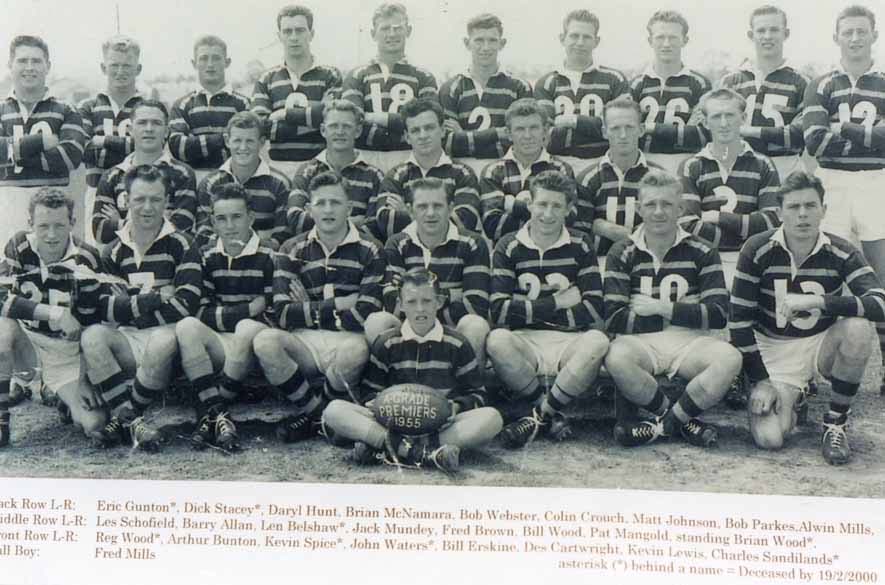
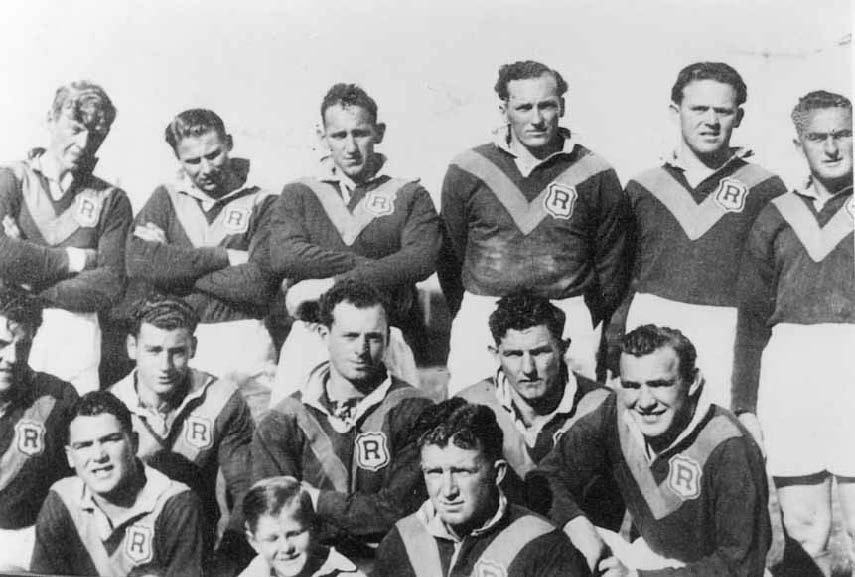
Back row; 1.Wally Brown 2. Tom Creighton 3: Danny Spice 4. Dick Dwyer 5. Neville Schofields 6. Toby Marlin
Middle row: 1. Horrie Davis 2. Jimmy Harper(Capt Coach) 3. Bill MacNamara 4. Brian Doolan 5. Jimmy Demmery
Front row: 1.Ike Schofields 2. Tony Harris B-boy 3. Billy Gaynor
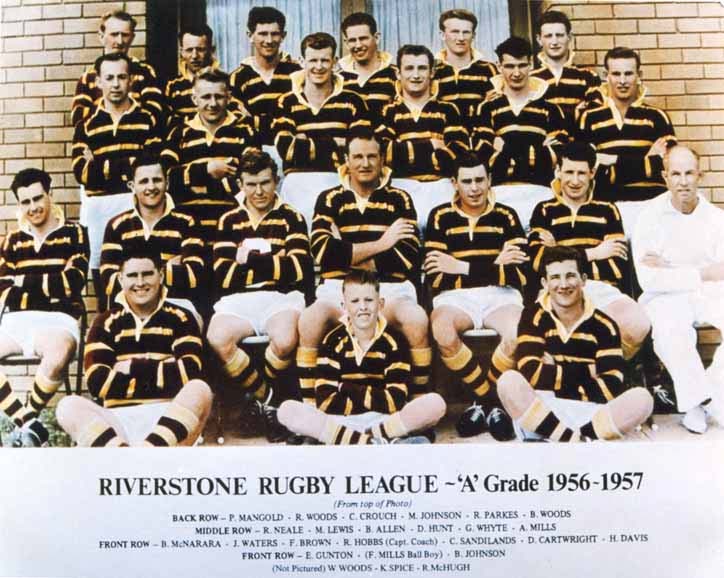
Jack Mundey was to become a controversial figure later in his life as the leader of the NSW Builders Labourers Federation, figuring prominently in the Green Bans disputes of the 1960’s. Being a member of the Communist party, he was savaged by the media of the day; he was thrown into gaol, but he was a survivor and is now credited with having saved the historic Rocks area of Sydney for the general public to enjoy.
Today, Jack Mundey is the widely respected President of the Historic Houses Trust of NSW.
The 1950’s was a golden era with the club winning both the ‘A’ Grade and ‘A’ Reserve premierships in 1956, and the following year the ‘A’ grade were beaten in the Grand Final. The ’56 and ’57 teams were coached by Bobby Hobbs.
Des Cartwright recalled training as a serious task in those days when after their practice Mick Woods would boil up a large pot of meat extract for the boys to enjoy.
Several players of this era went on to play Presidents Cup and district football with Parramatta -Bob McHugh, Des Cartwright, Bobby Hobbs, Brian McNamara, Colin Crouch, Charlie Sandilands, Ron Neal and Mattie Johnston. Mattie was captain of Parramatta club’s first premiership winning team, the 1964 third grade.
A promising player from this era was Johnny Waters, some believed he could have played for Australia one day. But fate struck a cruel blow when Johnny was killed in a car accident just after he finished playing the season in Parramatta’s President Cup team.
Another very promising player of this period to have his career cut short was Eric Magennis, who became a paraplegic after a motor cycle accident. But this setback did not dampen Eric’s enthusiasm for sport and in 1972 he won 2 Gold Medals at the 1972 Paraplegic Olympics held in Munich, and another at the games held in Toronto, Canada in 1976.
Another man who has contributed greatly to the success of the Riverstone club is Bill McNamara. After several years as a player he became a member of the committee and then served as the club Patron for many years. Throughout his life he continued this interest in football and gave up much of his valuable time to manage and coach the junior teams.
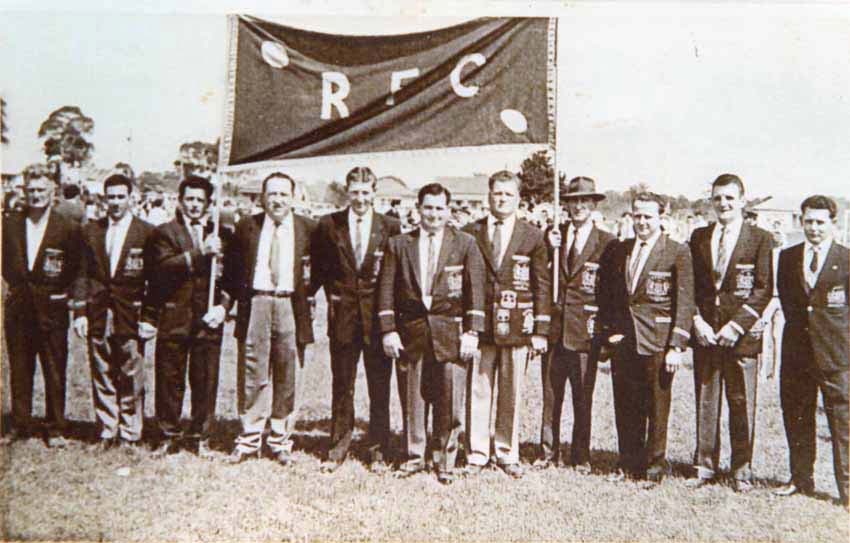
Left to Right: 1. Dick Stacy 2. Charlie Wheeler 3. Eric Crouch 4. Basil Andrews 5. Frank Crowley 6. Terry Wood 7. John Stacy 8. Charlie Smith 9. Rob Shepherd 10. Tony Robbins 11. Barry Crouch
He was the man responsible for building the Footballers Hall at the corner of Creek St. and Garfield Rd. He organised the removal of the two army huts from lngleburn and then provided much of the labour to help the volunteers to assemble it. The hall was opened in 1957 and was widely used for Balls, dances, wedding receptions, parties , club meetings etc. for the 30 years it existed.
Bill’s loyalty to the Riverstone Club continues today, when the club in 2005 celebrated its 90th Anniversary Bill purchased at the auction, the magnificent collection of photos and memorabilia that are on display today in the Riverstone RSL Club.
It was a source of amazement to many people as to how such a small settlement as Riverstone could compete so successfully against teams from areas with much larger populations. Riverstone in the early 1950’s was playing teams that represented Wentworthville, Merrylands, Guildford, Liverpool, Blacktown, St. Marys, Penrith and Richmond.
No doubt the support the club received from the community was a big factor, in the 50’s the town would be deserted whenever there was a home game. This support was still evident in the 1970’s when the Riverstone High School team played in the University ‘Shield, a competition between teams from High School from all over the State.
These matches were usually held on a Friday afternoon and when held at Riverstone, local shops have been known to close to allow supporters to attend. For some unknown reason industrial unrest would develop at the meat works, resulting in a strike from midday. Needless to say there was always a huge crowd at the oval to support the local school that afternoon.
When Penrith was admitted into the Sydney competition in 1967 Riverstone came into their Junior League organisation.
Ron Bates became involved with the club at this time. His thoughts and recollections from the 70s till the 90s are recorded here:
Names from some the older families of Riverstone still appeared in the programs -McNamara, Britton, Smith, Watton, Johnston, Drayton, Parkes, Wallace and they were now joined by such names as Petrow, Olejarnik, Poniewierka, and Wolffe.
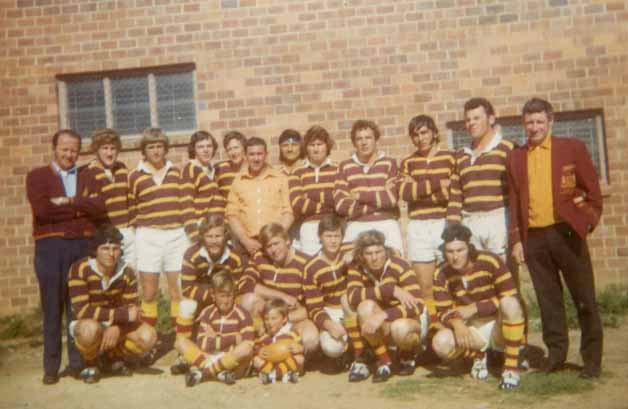
Back row: 1.Robbie Shepherd, 2.Peter Culina 3. Colin Watton 4. Brian Strachan 5. Brian Wallace 6. Charley wheeler 7. Ted Ritowski 8. Robert Shea 9. John McNamara 10.Werner Poniewerka 11.Harry Minton 12. Des Cartwright
Front row: 1. Maurie Smith 2. ? 3. Alan Watton 4. Lyle Cunich 5. Ricky Smith 6. Neville Fussell John Judge -ball boy John Liepa -mascot
Charlie Wheeler, after coaching the junior teams for several years took control of the ‘A’ Grade and was an immediate success, with the club winning both the ‘A’ grade and ‘A’ reserve premierships in 1971 and 1972. Ron recalled the celebrations lasted for weeks.
1971 was the clubs most successful year when from 12 teams they had 7 teams reach the semis and 5 won their premierships. But the year was also tinged with sadness when the club lost its greatest supporter, Basil Andrews.
This obituary appeared in the Riverstone Press at the time his death in September 1971.
Vale Basil Andrews ‘The sudden and tragic death of Basil Andrews recently has taken from the Riverstone community one of its best loved and most respected members. His unselfish and tireless devotion to any task he undertook endeared him to all who came in contact with him, and a measure of the popularity and respect in which he was held was seen at the church service and in the funeral procession.
As well as personal mourners, representatives of all local Junior League clubs were in attendance, as were members from clubs in the Parramatta Junior League and Penrith District Club.
In his lifetime Basil had been associated with many organisations to which he gave that unswerving loyalty and attention that became his trademark, but perhaps the most lasting memorial to his name will be the time and effort he gave to the Riverstone Rugby League.
At the age of 16 he was a delegate to the Western Districts Junior League, he was a member of Riverstone’s premiership winning side prior to the outbreak of World War 2, and was a reserve for the Presidents Cup side that year.
At the outbreak of war he enlisted in the A.I.F. and served with distinction throughout the war. Even while serving overseas he never lost his love for Riverstone League, and donated a trophy to be competed for by young footballers in his town, still playing the game.
On his discharge from the Services he returned straight back to the community and the Riverstone Junior League, and here began an unbroken run of 25 years of dedication and work for the club.
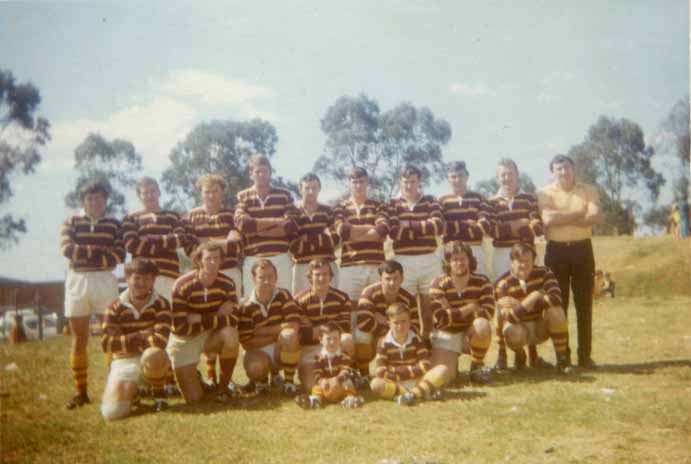
Back row: 1.John McNamara 2.Bobby Gill 3. Warren Irvine 4. George Simpson (Cpt) 5.John Freeman 6. Jimmy Simpson 7.Tommy Haines 8. Peter James 9. Graham Britton 10. Mick Shields
Back row: 1.Michael McNamara 2. Boyd Hart 3. Mark Willard 4. Glen Whitehead 5. ? 6. Mick Carter
Front row: 1.”Stitch” Burtton 2. Tony McNamara 3.Barry Drayton 4. Phi1 Creek 5. Graham Magennis 6. Robert Shea 7. ?
For almost all of those years he was Secretary and was always on the executive side of the committee. For the 2 years that Riverstone amalgamated with Richmond he was their Treasurer, and on the return of Riverstone as a single club he became their Secretary again, a position he held until his untimely death.
It can be said that all the footballers in Riverstone since the War (and there have been many good ones), have passed through Basil’s hands. He was a quiet and unassuming man who seemed to bring out the best in anyone associated with him, either as a player or a fellow committeeman.
Throughout the lean years when Riverstone was struggling to field sides, Basil was almost a one man army. With the help of a few others, he held the club together, raising money one way or another to help keep the club on an even footing until they weathered the storm.
He was also an instigator of the fielding of smaller grade sides in the town and in the beginning he not only arranged transport for them to the various grounds, but he helped coached them as well.
I think he would have been proud to know that the funeral cortege passed through a guard of honour of young footballers wearing their blazers or jumpers in the colours he loved, and knew so well. In recent years while not enjoying the best of health, he still kept an unflagging interest in these younger players just as he did the senior sides.
Recognition of his work came to him in his later life. He was a life member of the Riverstone Rugby League Club and through his lifetime of work fostering and encouraging the game of Rugby League he was made the first Life Member of the Penrith Junior Rugby League, an achievement of which he and all League followers can be justly proud.
It is not so well known that he was also one of the founders of the Riverstone R.S.L. and only had to fill out the necessary forms to become a Life Member of that body. At different times he was also a member of the Riverstone Park Committee and I’m sure he gave that job the same care and attention of any job he undertook.
To me, Basil Andrews stood for all that was fine and decent in this world and certainly Riverstone is all the poorer for his passing. Generous to a fault, he was intensely proud of his town and his country, Through his unassuming ways he had a host of friends, and I was honoured to be among them.
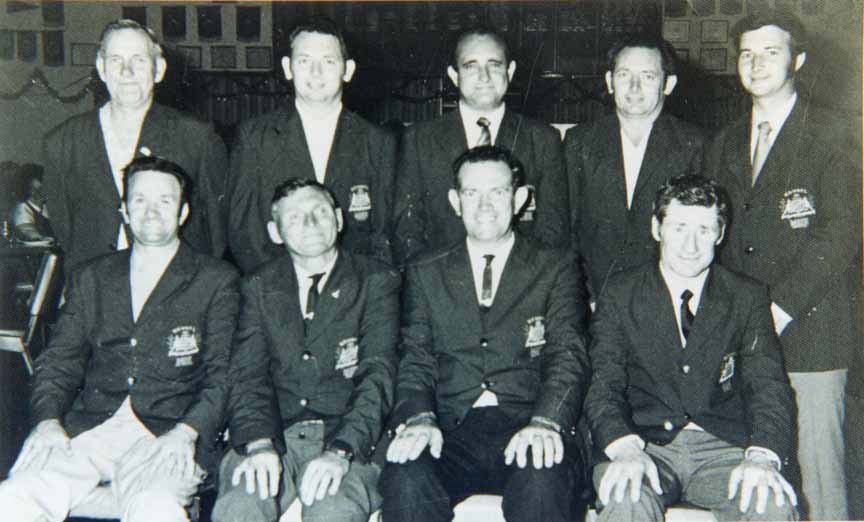
Back row; Geoff Binks, Eric Crouch, Ron Bates, Bany Crouch, Bill Denman
Front row: Alan Drayton, Eric Martin, Johnny Judge, Des Cartwright.
His death not only leaves a gap, which is irreplaceable, it leaves many of us without wise counsel and a true friend. From this can be said of Basil, to live on in the hearts of those we left is not to die.
In humble tribute
‘Balmain’
The 1970s saw a large increase in the number of junior teams and the club was fortunate to have a willing group of supporters to coach and manage these teams. Names that come to mind are Johnny Judge, Eric & Barry Crouch, Ron Bates, Des Cartwright, Alan Drayton and Rob Shepherd. Ron recalled the Windsor/ Richmond games against Riverstone, which were always a tough battle, characterised by a real love-hate relationship, but all were the best of mates.
Throughout the ’70s the club won more than its share of premierships and also won the club championship in 1976 and 1992. The club again won the A grade premiership in 1988, 1989 and 1990. Players from Riverstone that went on to play grade with Penrith include Roy West, Ken Wolffe, Geoff Pfister and Zac Olejarnik.
By the 1980s the clubs grounds received a big boost’ with the construction of new amenities and grandstand. The oval was fenced and underground watering was supplied. The work was done by Blacktown Council with a lot of help from club members.
Ron said one friend he did want to give special thanks to was Russell Magennis -a mate who was always there to lend a hand. He has coached and managed teams, marked the fields, became club president, was the clubs best seller of raffle tickets, you name it, he’s done it.
Ron Bates was Secretary of the Riverstone club from 1968 to 1982 and was rewarded with Life Membership. He was also made Life Member of the Penrith District J.R.L. for his years of service to that club.
His best memories of the club include -the presentation days for the kids at the end of the season, the trips away with the kids teams, selling raffle tickets at the Tourmaline Hotel, the selling of doubles on the Commonwealth Bank corner on Friday afternoon and Saturday morning. He also has good memories of the Bowls days and socials held at the Bowling Club, the barbecues after the home games and the many celebrations held in the footballers hall.
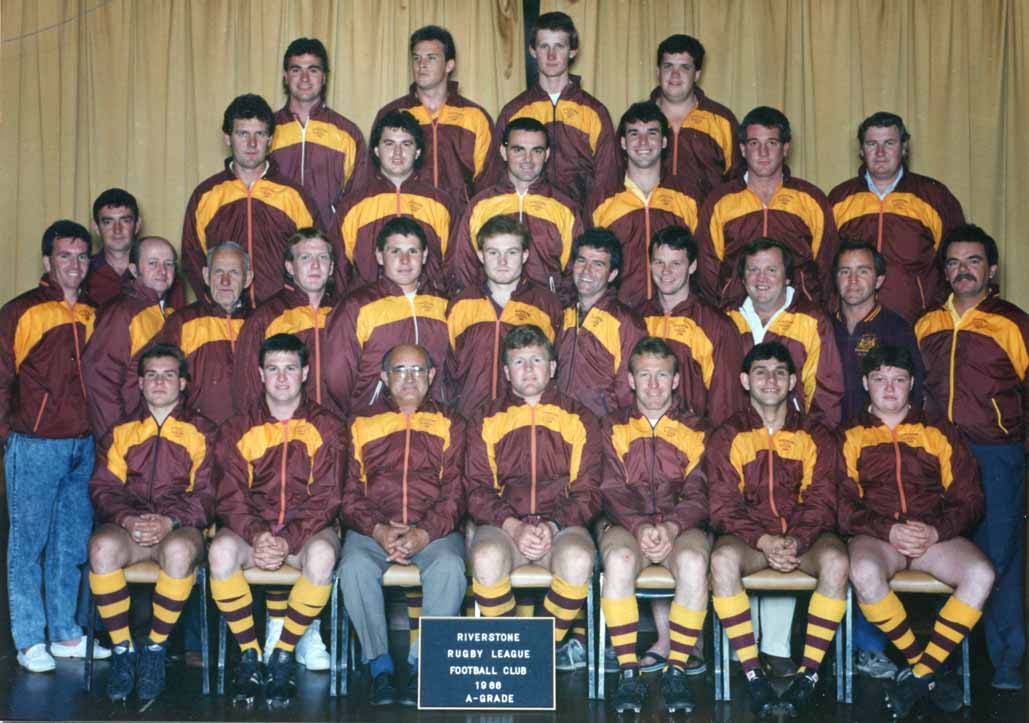
Back row: 1.Barney? 2.Grant Burgman 3. Paul Melanic 4. Geoff Hunter
3rd row: 1.Michael McNamara 2. Boyd Hart 3. Mark Willard 4. Glen Whitehead 5. Robert Butler 6. Mick Carter
2nd row: 1.Colin Russell 2. Steve Tolsher 3,Robbie Shepherd 4. Geoff Binks 5. Gerard Cobcroft 6.Evan Gunton 7.Brett Lloyd 8. Brian Davies 9. Robert Parkes 10. Bobby Cairns
11.Bany Drayton 12. John Davidson (Coach)
Front row: 1. ? 2. Max Marlin 3. Ron Bates 4. Graham Barlow 5. Trevor Niass 6. ? 7. Lyle Mackie
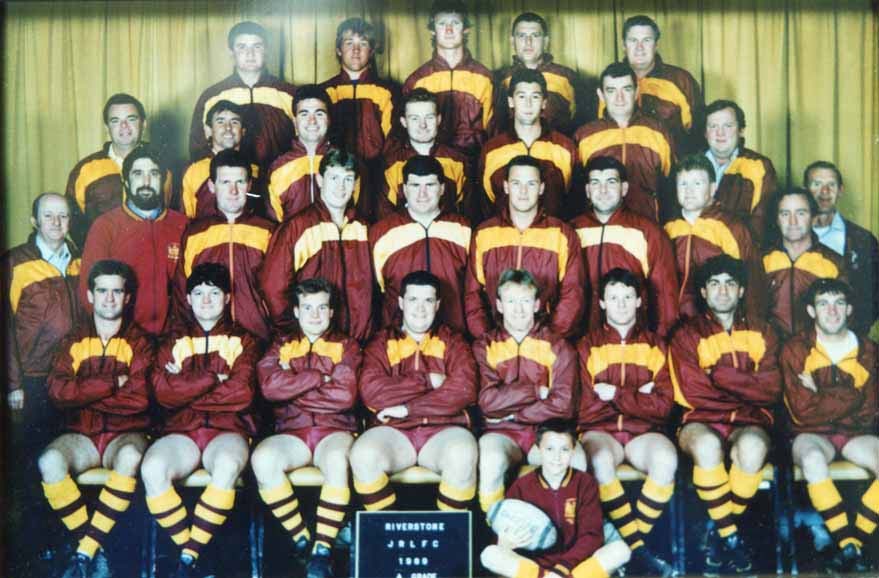 Riverstone “A” Grade premiers 1989
Riverstone “A” Grade premiers 1989
Back row: 1. Steve Welfare 2. Kirk Drayton 3. Paul Melnick 4. Paul Lewis 5. Mick Carter2nd row: 1. John Davis 2. Peter Wijnans 3. ‘Barney’ 4. Brett Lloyd 5. Ernie Lundt 6. Steve Tolsher 7. Bob Cairns 8. Graham Britton
3rd row: 1. Rob Shepherd 2. Jim McTaggart 3. Michael McNamara 4. ? 5. John Cartwright 6. Grant Burgmann 7. Darryl Harris 8. Graham Barlow 9. Barry Drayton
Front row: 1. Graham Hunter 2. Lyle Mackie 3. ? 4. Geoff Hunter 5. Trevor Niass 6. Robert Parkes 7. Barney ? 8. Neil Wolffe
The backbone of any successful club is the committee, Riverstone has always been fortunate to have many members who have been prepared to give a lot of their time to the club. The club has recognised many of these members with Life Membership and they are:
Charlie Harris, Basil Andrews, Bill McNamara, Frank Crowley, Bobby Parkes, Eric Gunton, Geoff Binks, Ron Bates, Eric Crouch, Barry Crouch, Alan Drayton, Des Cartwright, Eric Martin, Johnny Judge and Bill Denman.
The Riverstone Club changed its name to the Riverstone Razorbacks in the year 2000.
When the Penrith Panthers defeated the highly fancied Sydney Roosters in the 2003 Grand Final, the team comprised 2 players who had played all of their Junior football with the Riverstone Club. They were Shane Rodney and Joel Clinton; Joel Clinton continued his outstanding season by being selected to tour with the 2003 Kangaroos to England.
Compiled by Clarrie Neal from information and photos provided by Bobby Parkes, Ronnie Bates, Graham Barlow, and Dessie Cartwright, February 2000.
Later details have been added as they eventuated. Many of the old programs on display at the museum were provided by Geoff Binks, another grand supporter of the club from the late 1940’s to the 1980’s.
Persak Family History
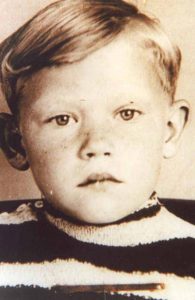
CHARLEY PERSAK
I was born Volodymyr Demeczyk on the 11th January 1943 in Dombrowa, Poland. My father Stanislaw was Polish and my mother Tatjana was Ukrainian, I was the first of their 3 children. My brother Josef was born in 1950 and sister Erica was born in 1955, both were born in Riverstone.
My mother’s family were quite wealthy share-farmers in the Ukraine and lived off the land, growing all their food and meat in the few short months of their summer. With no electricity or refrigerators they used to bury their food in the snow and use it as required through the long winters.
When the Russians invaded Ukraine they confiscated all their land and farms; my mother aged 18 fled to Poland where she met and married Stanislaw. The family were to experience all the horrors of World War 2 . I recall my mother saying when I was born she was afraid to put me down, she carried me everywhere for the first 2 years of my life. It was sad, but people losing their babies would actually steal other people’s babies and children to replace their lost ones.
Barely three years old at the time, I still have memories of the bombs dropping, the blackouts, the snow drifts, and the day I got lost in the snow. I recall the day the Americans made us drop everything and rushed everybody outside from their buildings, prior to the area being bombed.
I remember the day I found all this paper money in a garbage bin; money in times of war becomes valueless, but I didn’t realise this at the time. Leaning into the bin to get the money for my mother I fell in, dad found me with my feet sticking out and very grubby from the garbage. I got into big trouble that day as I had just had a bath and was dressed in my good clothes. It was a lot of work keeping a kid clean in those days, there was no running hot water and the water had to be boiled in a kettle; you washed in a round tub on the floor with an inch or two of water, no matter how cold the weather was.
Another time I was sent to get some rations from the store and took so long my father came looking for me. He found me waiting to cross the road, watching a huge convoy of American Army trucks and tanks come rolling into town, a ‘show of might’ so big it seemed to take ages to pass.
As the war ended our family was sent to a refugee camp for an unknown period – maybe a year or two, while awaiting transport to Australia or Canada.
I became very sick in Naples and for a time it was thought I would be unable to travel with my parents. Mother put hot poultices on my chest and nursed me day and night back to good health. The problem had been caused by eating too many tomatoes and peanuts, produce that I had never seen before in my life until I came to Italy.
Dad chose Australia and we sailed from Naples in July 1949 on the converted American troopship, “General W. M. Black.” As with other migrant ships, the men and women lived in different parts of the ship. As the youngest child on the ship I felt I had the run of the ship, the crew spoiling me with a never ending supply of chocolates and ice-cream. The family arrived in Australia on the 29th November, 1949.
We disembarked in Sydney and were transferred by bus to the migrant camp at Parkes in western NSW which had been an Army camp during the war. We were housed in what they called “Nissan Huts”, big round topped buildings about 100 feet long and capable of holding lots of families. My father was given a job on the railways so we returned to Sydney and lived in tents located adjacent to the railway yards at Clyde. My father had money deducted from his wages to pay back the cost of bringing our family out from Europe (unlike today).
When Dad had saved enough money he bought a small block of land in Creek Street, Riverstone and began building a shack made of wooden shipping cases. The wooden cases were bought from Knight’s Garage and had been used to bring cars into Australia from overseas. We lived in this shack until Dad bought another house on the opposite side of Creek Street. Dad left the railways after a few years and got a job at Max Gosdens saw mill in Edward Street, where he worked till he retired.
I was now 7, could speak German, Polish and Ukrainian, and had to start school to learn English. My Mum changed my name to Arnold Persak, because it was easier for the teachers and children to remember and might help me integrate more quickly. I went to the Catholic Primary School in Riverstone and with no knowledge of English found it very difficult at first. One day I walked all the way home(2 kms) in the middle of lessons to go to the toilet, because no one had told me there were toilets at the school. When I had learnt a little English I did better at school and got quite good grades, especially for neat work.
At about age 8 my school had a baptism day and they asked me if I had been baptised; I said no, so they baptised me. The priest asked me my name; I had a best friend called Charley so I told the priest my name was Charley. And that is what my mother, father and everyone called me from that day on. Though my mother’s pet name for me became “Chalka”.
Growing up in Riverstone was great; it was a small country town on the outskirts of Sydney and we still had dirt streets. A railway line ran through the town and steam trains, both passenger and stock trains, were a common sight. At the railway gates there was a big water tank about 30 feet in the air on a stand so the trains could pull under and fill up with water to make the steam. There was a meatworks and a textile factory in town and they employed most of the townsfolk. I used to walk while I was at primary school and later at high school in Richmond I had to take the steam train.
We had to bathe twice a week in a tin tub on the floor with the water heated on two primus stoves. At times I remember Mum taking the clothes to the creek to wash them. The creek often flooded, in 1956 there was over 4 feet of water in our house and we were billeted in the Masonic Hall in Garfield Rd, now used as the museum.
I was expected to do lots of chores around the house even when I was quite young. We had a huge veggie garden where Mum grew most of our food, my job was to help weed and chip it. We had a jersey cow and we all just loved the still warm fresh milk, mum made all our butter and cheese. Once when I was age 8 and my Mum was in hospital having my little brother Josef, it was my job to milk the cow. The cow didn’t really know me, and no matter how hard I tried I couldn’t catch her. So I went inside and got one of mum’s dresses and put it on. I walked back down the paddock with my bucket, and the cow just stood there and let me milk her.
My friends and I used to play around in the creek down the back of our house. We would swim, build cubby houses and swing out of the trees on a rope and fall into the water. We spent all our time outside, I don’t think we ever wore shoes. There was no television in Australia in those days. My friends used to ask me to ask my Mum to make us ‘platzky’ or ‘pirogi’. ‘Platzky’ are either potato pancakes or flour pancakes. ‘Pirogi’ are little pillows of dough filled with mashed potatoes and cheese and fried with butter and onions. Delicious!!!.
Mum would cook for a week just before Easter and we would go to church on Good Friday. On Saturday mum would spend all day in the kitchen again cooking. We had schitznels, we had sauerkraut, potatoes, pirogi, platzky, mushroom sauces and trifles. We had bowls of everything and we would take it to church on Saturday night to be blessed. Sunday was the day for the feasts of all feasts, family and friends would all get together to eat and eat. There were a lot of European families in Riverstone and it was a lovely community spirit. We never had any chocolate or candy Easter eggs. It was more traditional for Europeans to paint pretty pictures and patterns on boiled eggs for the children, so that’s what we got. Plus the feast of course , which was most important.
Christmas was another fun time for all the families to get together to eat and meet; it was the same then. Mum would cook for days and we would eat it all in one day. We didn’t get any Christmas presents either, as most of the money went towards food and education for us. Although I do remember when I was 12 getting a push bike for Christmas, but as it turned out I could only ride it on weekends because dad rode it to work every week day. We didn’t really mind though, because we always had a full tummy and a warm bed.
Some days after school I recall playing near the station and receiving a shilling to run down to open and close the railway gates. When Mr. Murray owned the Olympia theatre I would chip and clear away the weeds behind the theatre and the meeting room, just to get free admission to the Saturday afternoon pictures. To get pocket money as a lad I remember helping deliver bottles of Noons soft drinks, also getting up early to help the iceman with his deliveries to the homes in our area. I recall the day the Vocational Guidance Officer came to the school and really put me down when he suggested I was more suited to being a garbage collector than a mechanic.
Although most of the old people have passed on, lots of their children and grandchildren still live in the area. We don’t have the big celebrations that we used to but when we get together, we still have a lot of fun and good memories. The spirit is still there.
I left school when I was 15 and worked as an offsider on one of A J Bush’s bone trucks before getting a job in the Textile plant where I worked for 7 years until it closed. My next job was with Parramatta Spare parts in their wrecking yard.
I decided the spare parts business was the way to go, so started buying in spare parts and storing them in a wardrobe in a chook shed in our backyard. I then went into business at the Creek St. address, the year was 1967. Some of my first customers were the Riverstone footballers who on training nights would leave their cars with me to change tyres or carry out repairs.
In the meantime Wally Woods had closed his business in Railway Terrace. Penfolds used the shop to sell their wines for a short period before it was taken over by H G Palmer Electrical Appliances. When they moved it was used as a Dry Cleaning business.
Charley, now looking for larger premises leased the building from Wally Woods for $300-00 per month. Charley bought the building for $17,000 in the early 1970’s and has never looked back. He opened an Auto Spares shop in Cowra in 1982, then opened another in Bathurst in 1985. He further expanded the business by opening a shop in North Richmond in 1989.
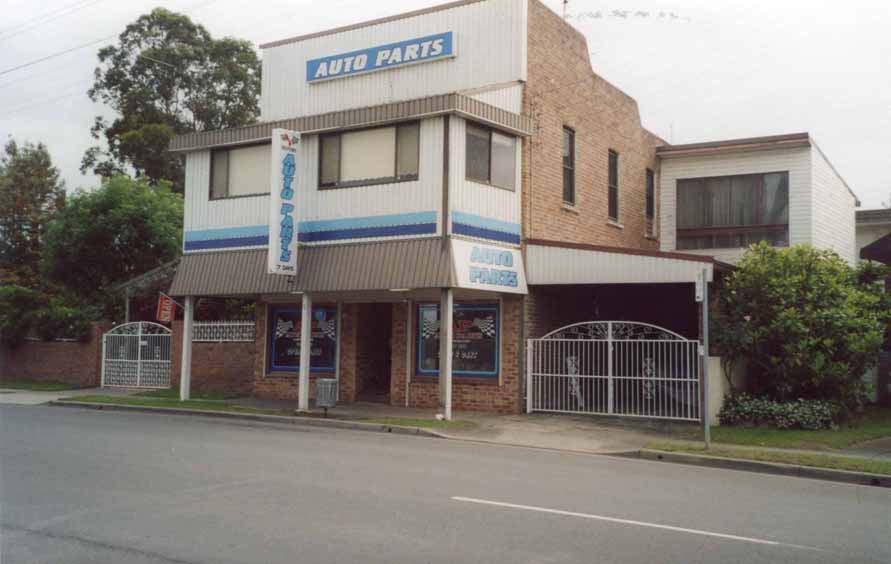
Charley worked hard to build up his chain of stores and never had time to take holidays, but one holiday he did do was a trip to China, a prize won from one of his suppliers for being their best customer. Finding the task of operating the 4 stores too demanding he sold his Cowra and North Richmond shops and now operates the Riverstone and Bathurst shops only. He, along with his wife Gwenda and son Adam, can still be found behind the counter in Riverstone, 7 days a week, 8 to 10 hours a day.
His wife Gwenda writes –
This story is a gentle reminder that you can be anything you want to be, you just have to ‘make it happen’. Everyone in Riverstone knows Charley and he has a reputation for being a bit of a grump. But he has the stock and everyone knows it, he loves his stock, he loves his business, and he loves Riverstone.
He is proud of the fact that the shop is a part of the early history of Riverstone. It was built in 1892 as a general store for brothers Charles and Thomas Davis, with Charles being granted a Colonial Wine licence in 1905. The store has continually served the community of Riverstone ever since.
His mother Tatjana passed away on the 16th December 1989. His father Stanislaw passed away on the 17th October 1995, both are buried in the Catholic section of the cemetery at Riverstone. His brother Josef moved to Western Australia where he worked as a consultant in the wine industry, before taking a position with Australia Post.
Gwenda and Charley Persak, 2006
ERICA PERSAK
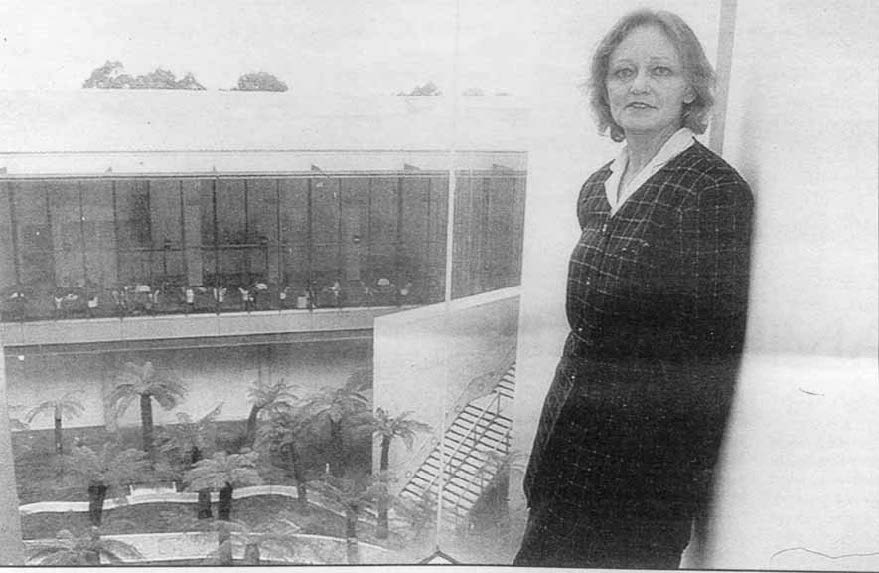 Erica Persak, General Manager, Collection Services, National Gallery of Australia
Erica Persak, General Manager, Collection Services, National Gallery of Australia
Erica Persak was born in Creek Street, Riverstone in 1955 to parents Stanislaw and Tatjana who had arrived from Europe in 1949. Riverstone is a small town in the Hawkesbury district, an area rich in the history of early Australian settlement, yet in the 1950’s and 1960’s the existence of museums in this area was limited. Erica attended the Riverstone Public School for her primary education and completed her secondary education at the Riverstone High School. Erica, a good scholar, always displayed a keen interest in history and in particular ancient history.
She left home to attend the Australian National University in Canberra, ACT where she pursued her interests in classics and history and graduated with an Honours Degree in history in 1977. Her major at University was on the US anti-slavery movement between 1830 -1836.
During her university career she developed a keen interest in research and decided to take up studies in the field of librarianship. She undertook a course in children’s librarianship where she developed an interest in children’s book; she recalled her most challenging and most humorous tutorial presentation was on the story of Goldilocks and the Three Bears, and how this simple fairy tale was re-interpreted in the late 19th and early 20th century.
It was during this time that the National Gallery of Australia was being built in Canberra and she watched its construction with interest. When Erica completed her graduate diploma in librarianship in 1979, she was offered positions at both the National Library of Australia and the National Gallery, for reasons she cannot explain she accepted the position at the National Gallery. Her first duties were to catalogue the Gallery’s collection of illustrated and artist’s books.
In 1980 she transferred to the Registry Department to work on a computerised collections management system. She recalls how nervous she felt the first time she handled an extremely valuable piece of art, it was the Henri Matisse painting of “The Abduction of Europa.”
On a private trip to America in 1981 she visited a number of US art museums to investigate their computerised collections management systems. She resigned from the Gallery in 1982 and went to America to work in the Arizona State Art Museum. While there she developed an interest in native Indian culture and spent every opportunity she could learning about and visiting cultural sites.
She returned to Australia in 1984 to accept the position of Registrar at the Art Gallery of Western Australia. This was an exciting and turbulent period for Erica as besides working with Elizabeth Churcher, she had contact with the entrepreneurs Alan Bond and Robert Holmes A’Court who at the time had both established significant art collections.
She returned to Canberra in 1993 to take up the position of Registrar of the National Museum of Australia. In 1996 Erica received her Graduate Certificate of Management Studies from the University of Canberra.
In 1997 after an absence of 15 years she returned to the National Gallery to take up the position of Registrar of Collections. In 1999 she was appointed General Manager of Collections Services, embracing the fields of Registrations, Conservation, Library Research and Photographic Studies. She is also responsible for programs that enable state and regional galleries to borrow items from the National Gallery for their own exhibitions.
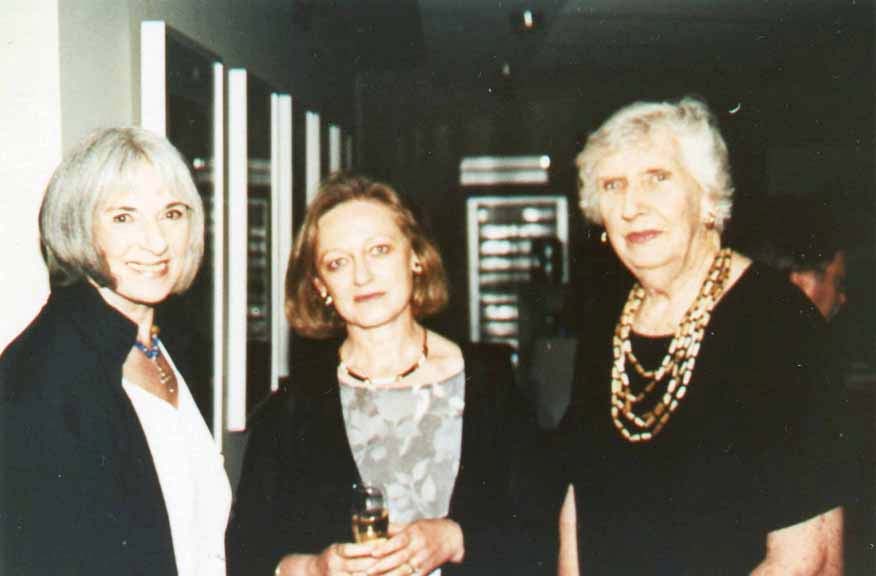
On the 16th December, 2006, Erica was presented with her Diploma of Fine Arts certificate and intends to continue studying for her Doctorate degree.
Clarrie Neal 2007
PS. Erica has returned to Western Australia and is now the Curator for business magnate Kerry Stokes private art collection. 2007
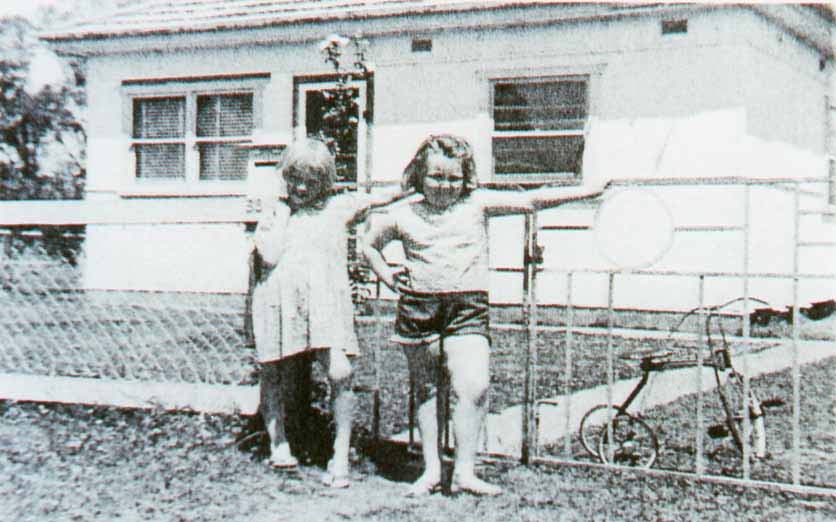
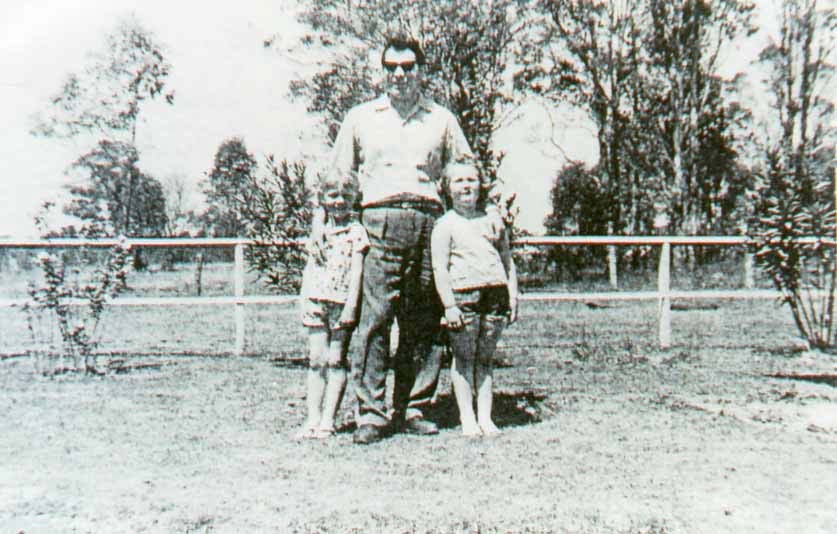
Olympic Games
by Philip Seale
“A funny thing happened on Bondi beach yesterday. There we all were having a party, dancing the macarena, grooving to Zorba the Greek, weaving a slow motion Mexican wave to the music from Swan Lake, when all of a sudden someone started a game of volleyball.” (SMH 26/9/00)
That was my experience of the Olympic games. Sure long days. In fact 30 long days without a break, however the atmosphere was electric for the whole time. No sign of the protesters who had threatened the event. Just 10,000 people there to have a good time and cheer on the Aussies.
My name is Philip Seale and I worked for SOBO, the Sydney Olympic Broadcasting Organisation, during the Sydney Olympics. SOBO was the host broadcaster for the entire games. They employed 58 outside broadcast facilities and over 3,500 staff. I lived in Riverstone for the first 24 years of my life and my mother is still there. My full time job is working for Network Ten as a Technical Director in the Sydney Studios. Ten kindly agreed to release me for the duration of the Olympics.
I worked at the Beach Volleyball at Bondi Beach as a technical operations centre supervisor. This involved ensuring all the television pictures and sound were of a high quality and overseeing the transmission of pictures to the Homebush International Broadcast Centre. All pictures were sent there via fibre optic cable for distribution to the international rights holders. I was also responsible to the other rights’ holders on site. These included NBC (USA), Televisa (Spain) and Globo (Mexico). Each of these companies had their own cameras to supplement their coverage and I provided them with the circuits required for their broadcast.
The crew at Bondi was truly international in make up. The majority were Canadian. Some were from the USA having had experience in Atlanta. The rest were English. Australians were definitely in the minority. For an event of this scale there are nowhere near enough experienced crew in Australia.
During the term of the games I was also called to assist at the Entertainment Centre. The crew there was made up almost entirely of Russian TV crew. It was found that they had a slightly different way of working than the rest of the world. We were called on to assist them to produce television pictures to the standards required by international broadcasters. This was quite difficult as my understanding of Russian was only slightly worse than their grasp of English.
On completion of the games I returned to work at Channel Ten. With a bit of luck I will be able to head to Salt Lake City to work on the winter Olympics in two years time. I only hope you can dance the macarena in the snow as well as you could on the sands of Bondi Beach.
Memories of the Olympia Theatre Riverstone
by Alan Strachan
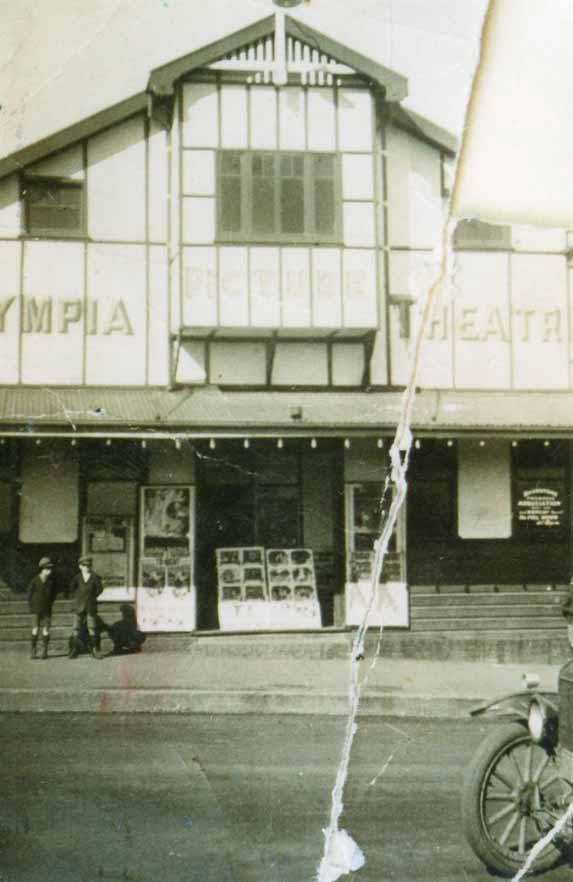
[Photo: Courtesy of Riverstone and District Historical Society]
[Caption by Alan Strachan –2005]
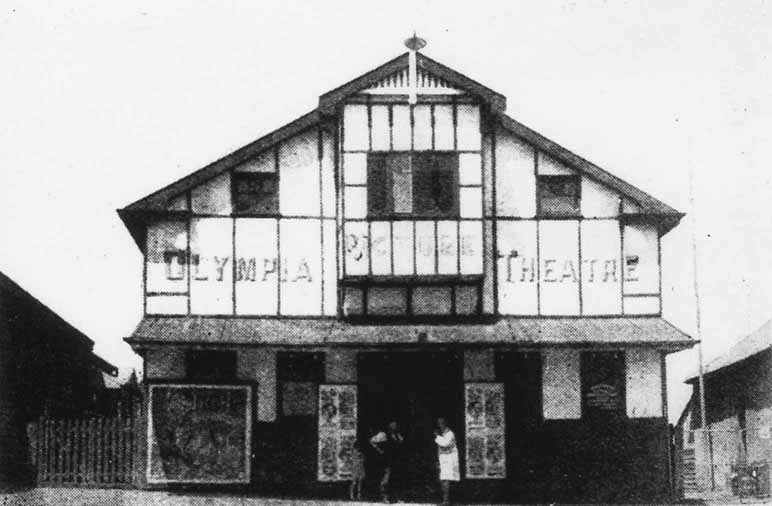 The Olympia Picture Theatre at Riverstone -photographed late in 1932. No electricity power poles or lines connected at this early stage. The protruding projection room above the corrugated iron slanted awning stands out, as does the flagpole at the right of the photograph. Mr. Raymond Kennedy Murrell or “Charlie” Murrell as he was called, was at that time the owner of the Theatre, having bought it from Mr. Robert Lindsay Harper in 1926. Mr. R. L. Harper had built this up-to-date Picture Theatre on the site in Windsor Road, [later Garfield Road] which was completed by the builder, Mr. J. Donaldson of Harris Park, Parramatta in early November, 1920 and opened for public entertainment on Saturday 20″ November, 1920 with ”Marriage” a film from the Fox Film Corporation starring Catherine Calvert in the leading part Promptly at 8 o’clock the Olympia Orchestra struck up the National Anthem and the crowded house rose to their feet. The pictures went through the machine most successfully, and to the approved and satisfaction of a thoroughly appreciative audience. Moving Pictures were shown at the ‘The Olympia Pictures” or “Olympia Picture Theatre” as it was known, every Wednesday, and Saturday.
The Olympia Picture Theatre at Riverstone -photographed late in 1932. No electricity power poles or lines connected at this early stage. The protruding projection room above the corrugated iron slanted awning stands out, as does the flagpole at the right of the photograph. Mr. Raymond Kennedy Murrell or “Charlie” Murrell as he was called, was at that time the owner of the Theatre, having bought it from Mr. Robert Lindsay Harper in 1926. Mr. R. L. Harper had built this up-to-date Picture Theatre on the site in Windsor Road, [later Garfield Road] which was completed by the builder, Mr. J. Donaldson of Harris Park, Parramatta in early November, 1920 and opened for public entertainment on Saturday 20″ November, 1920 with ”Marriage” a film from the Fox Film Corporation starring Catherine Calvert in the leading part Promptly at 8 o’clock the Olympia Orchestra struck up the National Anthem and the crowded house rose to their feet. The pictures went through the machine most successfully, and to the approved and satisfaction of a thoroughly appreciative audience. Moving Pictures were shown at the ‘The Olympia Pictures” or “Olympia Picture Theatre” as it was known, every Wednesday, and Saturday.
[Photo: Courtesy of Les Tod Collection]
[Caption by Alan Strachan –2005]
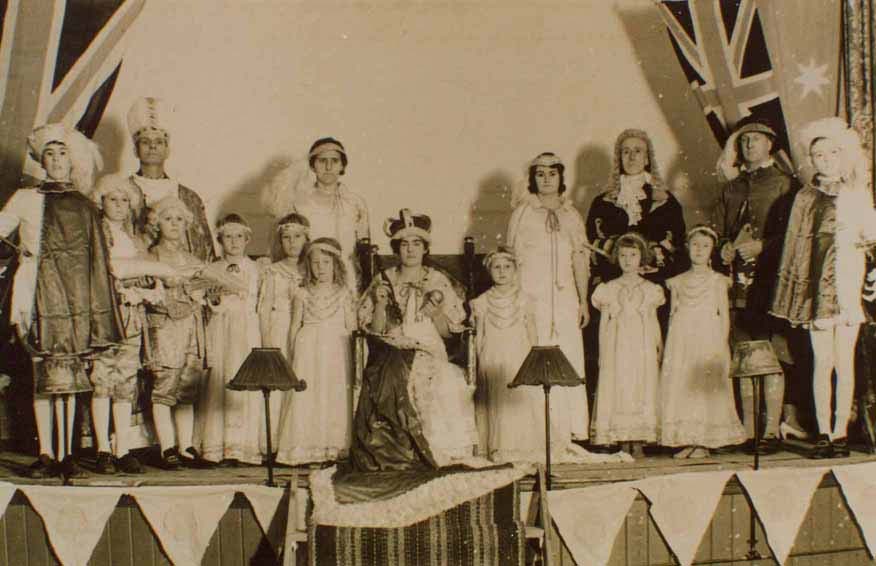 “Queen of Riverstone” crowning ceremony, which took place in the Olympia Theatre at Riverstone on Saturday 23rd June, 1934, during “Back to Riverstone Week”. Her Majesty The Queen [Nancy Strachan] is seated in the centre of the Royal Party on the stage wearing robes and crown. The hall was filled to capacity for this historical occasion. “Back To Riverstone Week” was to mark the turning-on of the electricity supply to the town for the first time. There was great rejoicing throughout the town when motor horns tooted, the fire bell clanged, and the sirens at the meatworks screeched noisy congratulations. The banquet was followed by varied entertainment such as a Baby Show, the crowning of the “Queen”, a Carnival and Ball.
“Queen of Riverstone” crowning ceremony, which took place in the Olympia Theatre at Riverstone on Saturday 23rd June, 1934, during “Back to Riverstone Week”. Her Majesty The Queen [Nancy Strachan] is seated in the centre of the Royal Party on the stage wearing robes and crown. The hall was filled to capacity for this historical occasion. “Back To Riverstone Week” was to mark the turning-on of the electricity supply to the town for the first time. There was great rejoicing throughout the town when motor horns tooted, the fire bell clanged, and the sirens at the meatworks screeched noisy congratulations. The banquet was followed by varied entertainment such as a Baby Show, the crowning of the “Queen”, a Carnival and Ball.
Her Majesty the “Queen of Riverstone” [Miss Nancy Strachan] in the centre of the stage, flanked on both sides by Princess Maud [Mrs Maud Stockwell, left] and Princess Beryl [Miss Beryl Jarrett, right], and between the Union Jack and Australian Flags. Others of the Royal Party are:- Two Trumpeters on either side of stage [Neville Waters and Jim Fitzgerald], The Herald [Mr L. Rosenthal] standing next to the a Trumpeter on the right side, The Chamberlain [Mr. Nelson Andrews] standing third from the right in back row, The Courtiers [Misses Joyce Wood, Elsie Schofield, Gwen Stanford and Mrs Gwen Hillier] .His Grace the Archbishop [Harry Moore] is positioned third from the left in the back row. Two Pages [Fred Dench and Cliff Conway] holding velvet cushions are standing next to a Trumpeter on the left in front of the Archbishop. Two Train- Bearers [Pat. Conway and Norma Clarke] positioned with the Courtiers at front of adults.
[Photo: Courtesy of Riverstone and District Historical Society Inc.]
[Caption by Alan Strachan –2005]
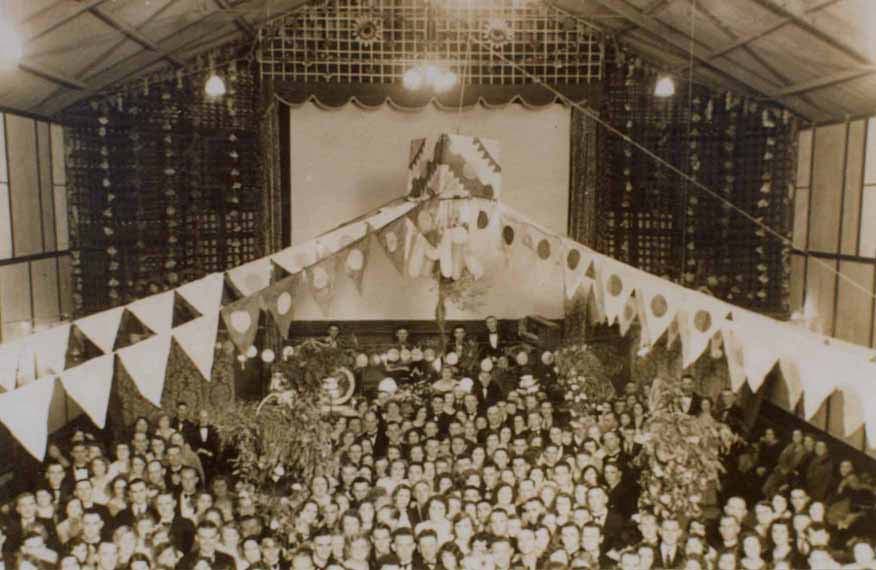 With the electricity supply switched on in the township, the Olympia Theatre was the venue of the “Back To Riverstone Ball” which was attended by 350 people, continuing through until 3 am. Saturday morning. This photograph shows the crowd at the “Ball” in the Olympia Theatre on Friday 22nd June, 1934. Herb Freeman’s band is seen in the background. Note the Plaster / fibrolite screen which was installed in the 1930s, and would remain in place until a CinemaScope screen was installed in early 1957, when Mr Neil Murray took over the management and running of the Theatre. There is a fringe above the screen. Also appearing in this photograph, is the latticework with decorations. The opened floral type curtains extend to the stage floor and there is a fringe across the top of the screen. The latticework that Mr Murrell introduced to the theatre, is at this stage, on both sides of the stage and above the screen area. The original ceiling is in place, and it was not until May, 1949 before Mr Murrell made application to have a new ceiling fitted to the theatre, with some latticework included. The hanging candlelabra lighting can be seen in the centre of the Theatre, and with the electricity supply now connected appeared much brighter. Later, when the new ceiling was built, there were two hanging candlelabra lights in the centre of the main hall and three lights in the Dress Circle.
With the electricity supply switched on in the township, the Olympia Theatre was the venue of the “Back To Riverstone Ball” which was attended by 350 people, continuing through until 3 am. Saturday morning. This photograph shows the crowd at the “Ball” in the Olympia Theatre on Friday 22nd June, 1934. Herb Freeman’s band is seen in the background. Note the Plaster / fibrolite screen which was installed in the 1930s, and would remain in place until a CinemaScope screen was installed in early 1957, when Mr Neil Murray took over the management and running of the Theatre. There is a fringe above the screen. Also appearing in this photograph, is the latticework with decorations. The opened floral type curtains extend to the stage floor and there is a fringe across the top of the screen. The latticework that Mr Murrell introduced to the theatre, is at this stage, on both sides of the stage and above the screen area. The original ceiling is in place, and it was not until May, 1949 before Mr Murrell made application to have a new ceiling fitted to the theatre, with some latticework included. The hanging candlelabra lighting can be seen in the centre of the Theatre, and with the electricity supply now connected appeared much brighter. Later, when the new ceiling was built, there were two hanging candlelabra lights in the centre of the main hall and three lights in the Dress Circle.
[Photo: Courtesy of Riverstone and District Historical Society]
[Caption by Alan Strachan –2005]
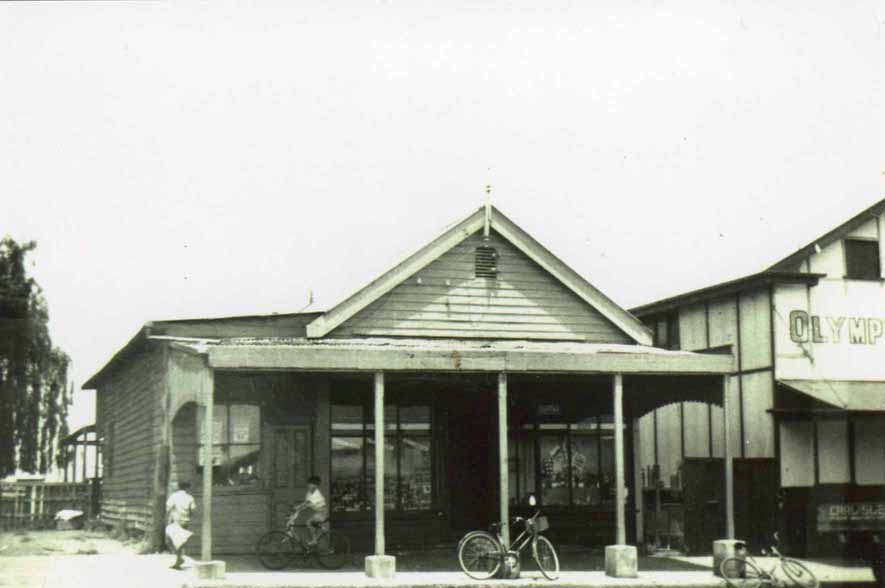 The shop in this mid 1930s photograph is the main subject of this frame, and was situated next to the Olympia Picture Theatre on the eastern side. The shop was owned by Horace & Phillip Barnbridge, who continued to own the shop until 1949 when it was then owned by Carlisles Pty. Ltd. After having the shop for seven years, Carlisles Pty. Ltd. disposed of their business to Mr Roy Cooke during May, 1955. The grocery store was yet again disposed of in 1958, when Mr Neil Murray bought the store. Today, it is the Riverstone Fruit Barn and owned by Pasquali Monteleone. Although, in the photograph, there is only a part eastern-side view of the Theatre, it shows the 12 foot [3.6 metres] pitch of the corrugated iron roof the flat sheets of fibrolite, a window, and the weatherboards up to the height of 5 feet [l .5 metres] from ground level.
The shop in this mid 1930s photograph is the main subject of this frame, and was situated next to the Olympia Picture Theatre on the eastern side. The shop was owned by Horace & Phillip Barnbridge, who continued to own the shop until 1949 when it was then owned by Carlisles Pty. Ltd. After having the shop for seven years, Carlisles Pty. Ltd. disposed of their business to Mr Roy Cooke during May, 1955. The grocery store was yet again disposed of in 1958, when Mr Neil Murray bought the store. Today, it is the Riverstone Fruit Barn and owned by Pasquali Monteleone. Although, in the photograph, there is only a part eastern-side view of the Theatre, it shows the 12 foot [3.6 metres] pitch of the corrugated iron roof the flat sheets of fibrolite, a window, and the weatherboards up to the height of 5 feet [l .5 metres] from ground level.
[Photo: Edwards Family Collection via Riverstone and District Historical Society]
[Caption by Alan Strachan –2005]
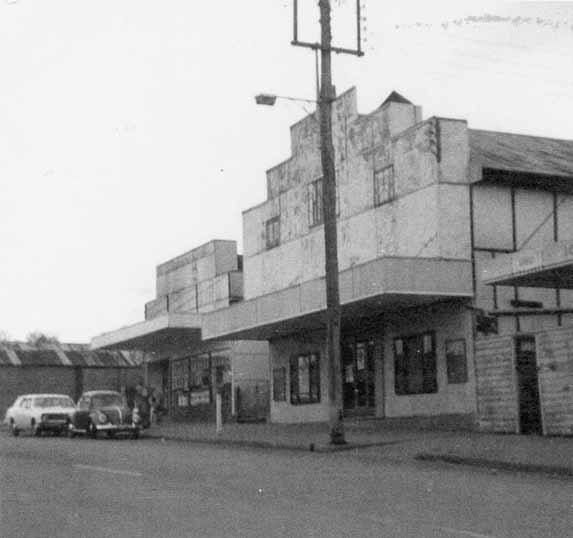 Looking east across Garfield Road, stands the Olympia Theatre in early 1972. The four showcases at the front of the Theatre are empty, and some other form [other than movies] of advertising is displayed and visible on the front glass door. The facade is stained and in need of a paint-job, as does Neil Murray’s [MFC Store] adjoining shop [Previously owned by Cooke’s]. Neil Murray adopted a design almost identical to that of the facade of the Olympia Theatre, when he took over the premises in 1958. Further up the road past the shop, is the hardware store building.
Looking east across Garfield Road, stands the Olympia Theatre in early 1972. The four showcases at the front of the Theatre are empty, and some other form [other than movies] of advertising is displayed and visible on the front glass door. The facade is stained and in need of a paint-job, as does Neil Murray’s [MFC Store] adjoining shop [Previously owned by Cooke’s]. Neil Murray adopted a design almost identical to that of the facade of the Olympia Theatre, when he took over the premises in 1958. Further up the road past the shop, is the hardware store building.
[Photo: Courtesy of Les Tod Collection]
[Caption by Alan Strachan –2005]
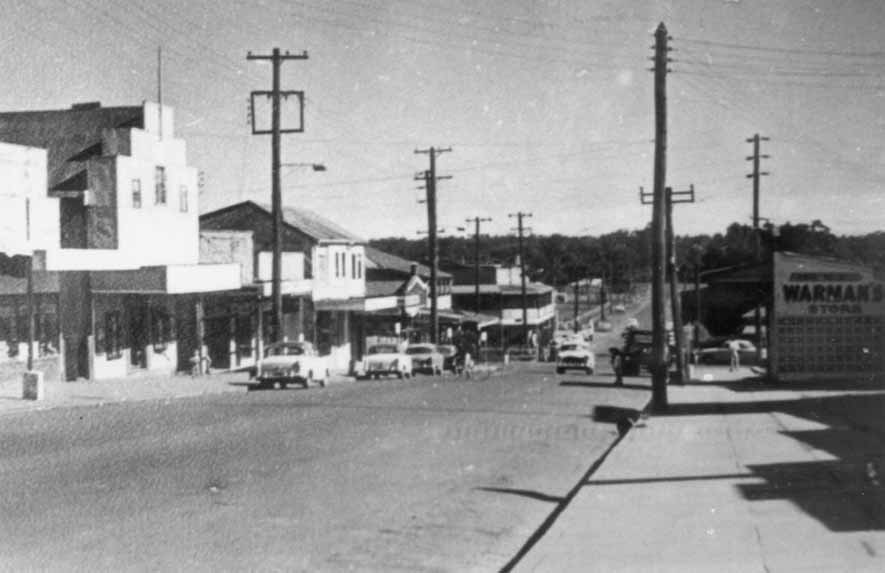 Looking South-East down Garfield Road -this photograph was taken in the afternoon of 1958. It clearly shows a portion of Neil Murray’s MFC Store, the front of the Olympia Theatre with all four glass show-cases, and the sliding glass door in place: then the Milk Bar, two other shops, the Wattle Milk Bar and Rosenthal’s shop on the corner. Across the railway line is the Royal Hotel. On the right side [northern side footpath] Warman’s Store is situated alongside of the hairdresser shop near the laneway. The parked cars on the left side of the street (south) are 1958 Holden Special Sedans with another coming up the road.This photograph was taken by Verlie Sullivan [Mick Sullivan was her father] then of Riverstone during late in 1958.
Looking South-East down Garfield Road -this photograph was taken in the afternoon of 1958. It clearly shows a portion of Neil Murray’s MFC Store, the front of the Olympia Theatre with all four glass show-cases, and the sliding glass door in place: then the Milk Bar, two other shops, the Wattle Milk Bar and Rosenthal’s shop on the corner. Across the railway line is the Royal Hotel. On the right side [northern side footpath] Warman’s Store is situated alongside of the hairdresser shop near the laneway. The parked cars on the left side of the street (south) are 1958 Holden Special Sedans with another coming up the road.This photograph was taken by Verlie Sullivan [Mick Sullivan was her father] then of Riverstone during late in 1958.
[Photo: Courtesy of Verlie Sullivan via Riverstone and District Historical Society Inc.]
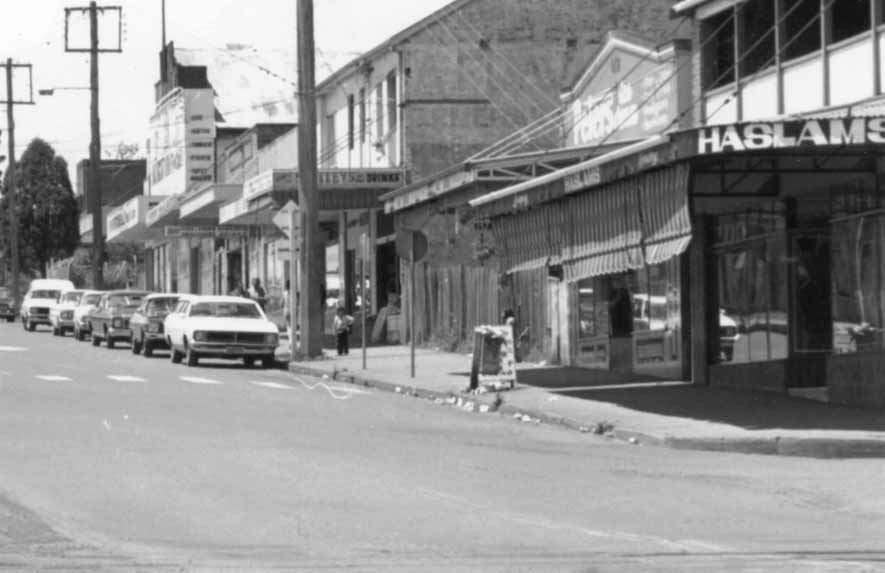 In this photograph, we are looking directly to the east along Garfield Road at Riverstone from the intersection of Railway Terrace at Haslam’s Store [formerly Rothenthal’s]. Past this store on the right is the Wattle Milk Bar, the hit shop, the “Blue Bird” Cafe, the Olympia Theatre building which at the time was being used by Michael and Freda Danziger of Rosebay, who had converted it into a commercial premises where auctions etc. were held. Beyond the Picture Theatre is Neil Murray’s MFC Store and the Riverstone Hardware. Directly across the road [northern side] is the Riverstone Post Office on the corner of Garfield Road and Pitt Street. This was the second photograph taken by Neville Biddle of Riverstone during the middle of the day in 1974.
In this photograph, we are looking directly to the east along Garfield Road at Riverstone from the intersection of Railway Terrace at Haslam’s Store [formerly Rothenthal’s]. Past this store on the right is the Wattle Milk Bar, the hit shop, the “Blue Bird” Cafe, the Olympia Theatre building which at the time was being used by Michael and Freda Danziger of Rosebay, who had converted it into a commercial premises where auctions etc. were held. Beyond the Picture Theatre is Neil Murray’s MFC Store and the Riverstone Hardware. Directly across the road [northern side] is the Riverstone Post Office on the corner of Garfield Road and Pitt Street. This was the second photograph taken by Neville Biddle of Riverstone during the middle of the day in 1974.
[Photo by Neville Biddle via Riverstone and District Historical Society Inc.]
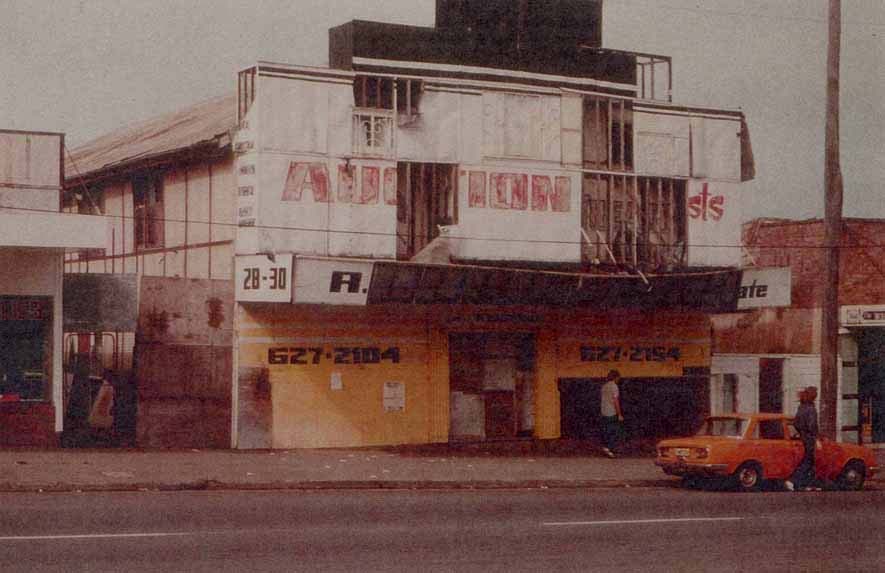 Early 1978 -looking south across Garfield Road, this photograph shows the now dilapidated and falling down Olympia Theatre building with sheets of tile board/masonite and fibro either missing or falling away from the studs. The front awning is close to collapsing onto the roadway. After closing, the building had been used for a few years for commercial purposes. It was during this time, and due to the lack of maintenance and upkeep, that the building deteriorated. It became more noticeable during 1977. About mid- 1978 the Olympia Theatre was demolished alter having stood as a Riverstone landmark for 58 years. It might be noted, that at the lower right-hand side of the sheet missing from the facade, the word “Theatre” can be seen on the original old facade, through the timber frame. Whilst on the left side where another portion has fallen off, the word “A” can be seen near “AUC”- [Auction]. This was the end of the word “Olympia”. The word “Picture” is still covered with the tileboard, where the Projection Room was located -spells out “Olympia Picture Theatre”.
Early 1978 -looking south across Garfield Road, this photograph shows the now dilapidated and falling down Olympia Theatre building with sheets of tile board/masonite and fibro either missing or falling away from the studs. The front awning is close to collapsing onto the roadway. After closing, the building had been used for a few years for commercial purposes. It was during this time, and due to the lack of maintenance and upkeep, that the building deteriorated. It became more noticeable during 1977. About mid- 1978 the Olympia Theatre was demolished alter having stood as a Riverstone landmark for 58 years. It might be noted, that at the lower right-hand side of the sheet missing from the facade, the word “Theatre” can be seen on the original old facade, through the timber frame. Whilst on the left side where another portion has fallen off, the word “A” can be seen near “AUC”- [Auction]. This was the end of the word “Olympia”. The word “Picture” is still covered with the tileboard, where the Projection Room was located -spells out “Olympia Picture Theatre”.
[Photo: Mr. L. Parry via the Les Tod Collection]
[Caption by Alan Strachan –2005]
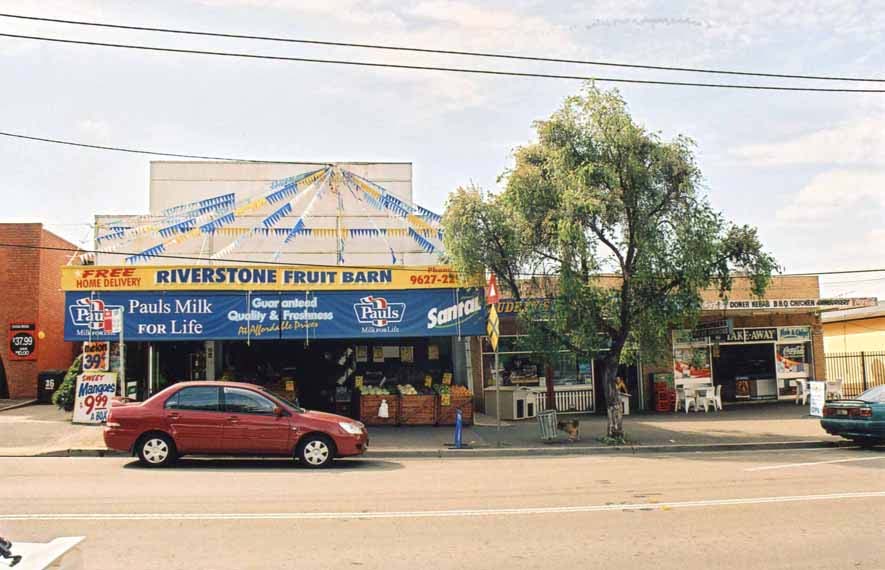 Today, a pet shop -produce and saddlery and a take-away cafe stands on the site where the Olympia Theatre once majestically stood. [Bottom] Site showing where Neil Murray’s MFC Store was located [now the Riverstone Fruit Barn] and where his Olympia Theatre once stood next-door.
Today, a pet shop -produce and saddlery and a take-away cafe stands on the site where the Olympia Theatre once majestically stood. [Bottom] Site showing where Neil Murray’s MFC Store was located [now the Riverstone Fruit Barn] and where his Olympia Theatre once stood next-door.
[Photo by Alan Strachan -Sunday 5th December, 2004]
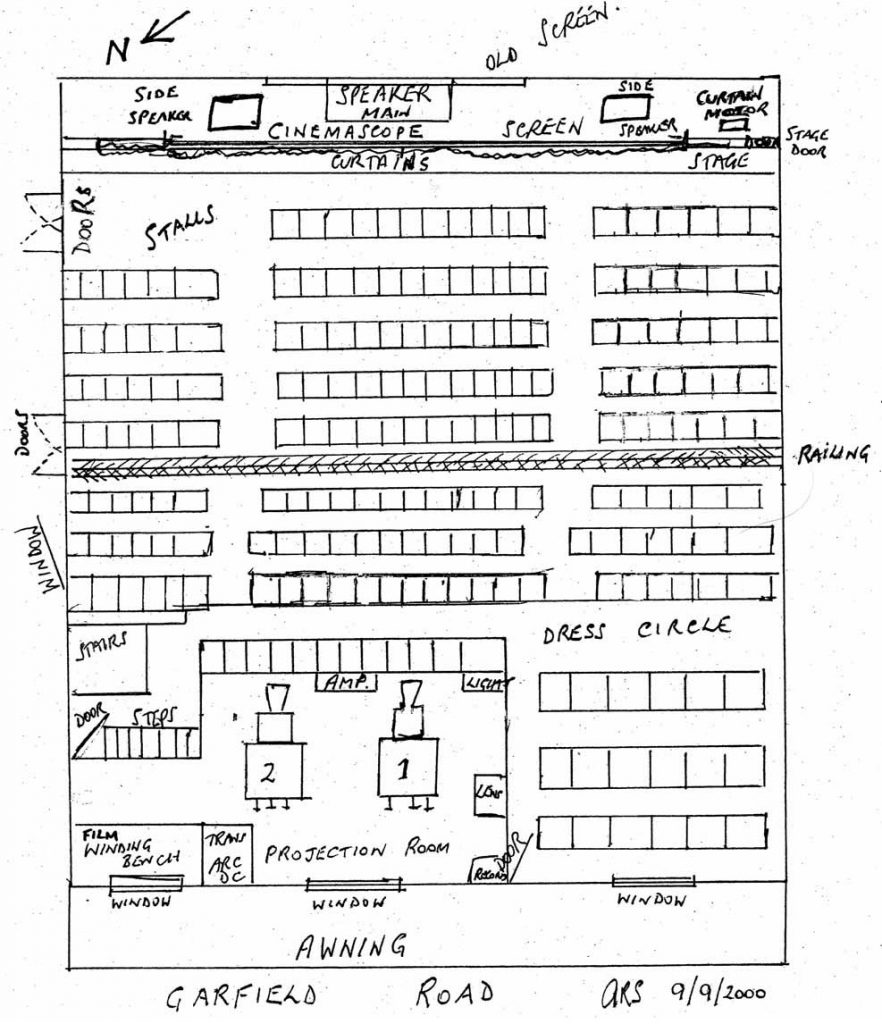
This layout of the Olympia Theatre Riverstone is not to scale. It is as recalled by the last Projectionist -Alan Strachan, and was prepared on 9th September, 2000. The layout shows the stage area with the old screen of fibrolite positioned behind the Cinemascope screen, main and two side speakers, curtains, curtain motor, and door to the stage on right. Also the stalls and dress circle. The number of seating arrangement may not be correct, as there were many changes made over the years. The Projection Room also appears in the layout.
The Windsor & Richmond Gazette of Friday 29mJune, 1934, describes the “Back To Riverstone” Ball which was held within the Olympia Theatre Riverstone on Friday night the 22″ June, 1934 -It is estimated that just on 350 people attended the “Back to Riverstone” Ball which was one of the most enjoyable social events of last week’s celebrations at that centre. The function was held in the Olympia Theatre on Friday night, and as a result of the effort it is expected that a goodly sum will be raised. The interior of the hall was nicely decorated with streamers, coloured electric lights, balloons and greenery, and presented a pretty appearance. Those responsible for the decorations were the ladies committee, comprising Mrs Ray Vaughan (President), Mrs Steer (Secretary), and Mesdames V. J. East, A. Smith, A. S. Jeffery, A Gordon, W. Vaughan, Sid. Turner, R. Hurley, J. Robbins, W. Piper and H. Bambridge. Mr. Tom Freeman’s orchestra played excellent music, whilst the duties of M. C. were carried out by Messrs. Ray Vaughan and P. Mason. With such a large crowd on the floor dancing, at times, was most uncomfortable, but no one seemed to mind -it was ‘Back to Riverstone” Week and everyone entered into the spirit of the evening. Among those present were quite a number of former residents, and they were accorded a right royal welcome back to the township. Supper was served in the Oddfellows’ Hall, the catering being in the capable hands of Mrs Curl of Windsor. Mr B. R. Hibbert had charge of the box-office, whilst Messrs. W. Parsons and S. Simmons were the door-keepers at the dance hall. Messrs. J. Wall and Dillon, Senr., had charge of the door at the supper room. So well did everyone enjoy themselves that when Mr Fisher mounted the stage, at the request of a few, and inquired whether it was desired to continue on with the function, the decision was a unanimous one. It was well into the wee small hours of the morning [Saturday] -3 a.m. to be exact -when the ball concluded, everyone being thoroughly satisfied with the night’s enjoyment and voted it one of the most enjoyable and successful functions of the celebrations.
So diversified was the programme at the “Back to Riverstone” Carnival that every section of the community was catered for -even His Majesty the Baby! The Baby Show held in the Olympia Theatre on Friday afternoon [22″rd June, 1934] was one of the outstanding and most pleasing features of the festivities. The hall was filled with mothers and babies -32 of them to be exact, ranging from 9 to 18 months of the girls and boys sections. Ribbons bearing the inscription, “Back To Riverstone Carnival” were placed around the neck of each winning baby by Cr. Page, President of Blacktown Shire Council.
To this very day [2005], Mrs Nancy (Strachan) Anderson, still resides in Riverstone, and has very fond memories of the occasion when she was crowned the “Queen” in the Olympia Theatre Riverstone. -“Long Live The Queen”.
Major Floods in Riverstone
Flood levels of the Hawkesbury River recorded at Windsor Bridge, floods 9.15 metres (30 ft) and over. Major floods shown in bold.
| Year | Month | Height (m) | Height (ft&ins) |
| 1799 | March | 15.25 | 50′ |
| 1800 | March | 12.2 | 40′ |
| 1806 | March | 14.64 | 48′ |
| 1806 | August | 14.33 | 47′ |
| 1806 | October | 9.15 | 30′ |
| 1809 | May | 14.64 | 48′ |
| 1809 | August | 14.49 | 47′ 6″ |
| 1816 | June | 13.88 | 45′ 6″ |
| 1817 | February | 14.03 | 46′ |
| 1819 | February | 14.03 | 46′ |
| 1819 | June | 14.03 | 46′ |
| 1857 | July | 9.91 | 32′ 6″ |
| 1857 | August | 11.44 | 37′ 6″ |
| 1860 | April | 11.21 | 36′ 9″ |
| 1860 | July | 10.45 | 34′ 3″ |
| 1860 | November | 10.98 | 36′ |
| 1864 | June | 9.91 | 37′ 6″ |
| 1864 | July | 10.98 | 36′ |
| 1867 | June | 19.26 | 63′ 2″ |
| 1869 | May | 11.21 | 36′ 9″ |
| 1870 | April | 13.72 | 45′ |
| 1870 | May | 10.83 | 35′ 6″ |
| 1871 | May | 11.21 | 36′ 9″ |
| 1873 | February | 12.66 | 41′ 6″ |
| 1875 | June | 11.82 | 38′ 9″ |
| 1877 | May | 9.15 | 30′ |
| 1879 | September | 10.52 | 34′ 6″ |
| 1879 | September | 13.91 | 43′ 3″ |
| 1889 | May | 11.74 | 38′ 6″ |
| 1890 | March | 12.12 | 39′ 9″ |
| 1890 | March | 10.52 | 34′ 6″ |
| 1891 | June | 10.83 | 35′ 6″ |
| 1894 | March | 9.68 | 31′ 9″ |
| 1895 | January | 9.3 | 30′ 6″ |
| 1898 | February | 9.61 | 31’6″ |
| 1900 | July | 14.08 | 46′ 2″ |
| 1904 | July | 12.22 | 40′ 1″ |
| 1916 | October | 10.83 | 35′ 6″ |
| 1922 | July | 9.45 | 31′ |
| 1925 | June | 11.36 | 37′ 3″ |
| 1934 | February | 9.15 | 30′ |
| 1943 | May | 10.11 | 33′ 2″ |
| 1949 | June | 11.97 | 39′ 3″ |
| 1950 | March | 9.2 | 30′ 2″ |
| 1950 | April | 9.2 | 30′ 2″ |
| 1950 | June | 9.45 | 31′ |
| 1952 | June | 9.35 | 30′ 8″ |
| 1952 | June | 11.61 | 38′ 1″ |
| 1952 | August | 9.71 | 31′ 10″ |
| 1955 | May | 9.76 | 32′ |
| 1956 | February | 13.7 | 44′ 11″ |
| 1956 | February | 11.56 | 37′ 11″ |
| 1956 | March | 9.81 | 32′ 2″ |
| 1956 | June | 9.53 | 31′ 3″ |
| 1961 | November | 15.1 | 49′ 6″ |
| 1963 | New gauge reduced by 305mm | ||
| 1964 | June | 14.51 | 47′ 7″ |
| 1969 | November | 10.06 | 33′ |
| 1974 | May | 10.28 | 33′ 9″ |
| 1978 | March | 14.31 | 46′ 11″ |
| 1978 | June | 9.55 | 31′ 4″ |
| 1986 | August | 11.3 | 37′ 6″ |
| 1988 | April | 12.65 | 41′ 6″ |
| 1988 | July | 10.74 | 35′ 3″ |
| 1990 | April | 9.8 | 32′ 2″ |
| 1992 | February | 11 | 36′ 1″ |
Flood types and effects:
- MINOR – From about 5.8 m
Causes inconvenience, minor roads & low-level bridges affected. - MODERATE – From about 6.9m
Overbank flow occurs with damage to low lying homes and farms. North Richmond bridge closes at 8.4m and Windsor Bridge at 6-9m. - MAJOR – From about 12.2m
Widespread inundation. Large areas flooded, towns & properties isolated & waters encroach. Extensive damage and hardship can occur.
Source: Flood Levels from Hawkesbury Gazette, Sydney Gazette & Macquarie Country. Description from Civic News August 1988, p. 9, inserted in the Hawkesbury Gazette 1988.
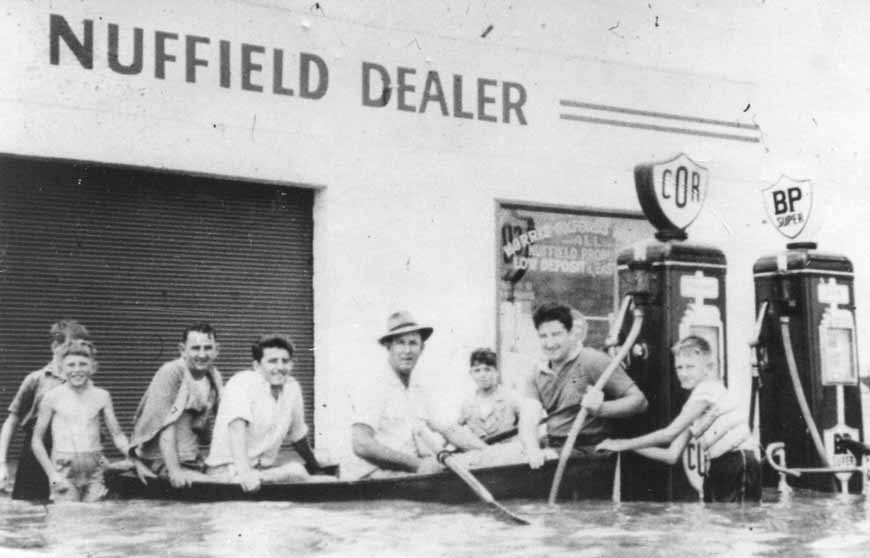
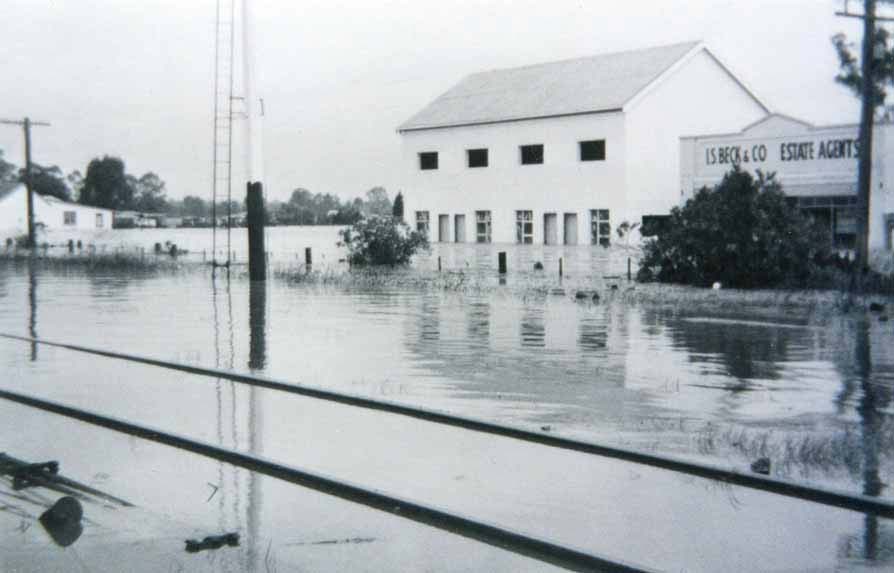
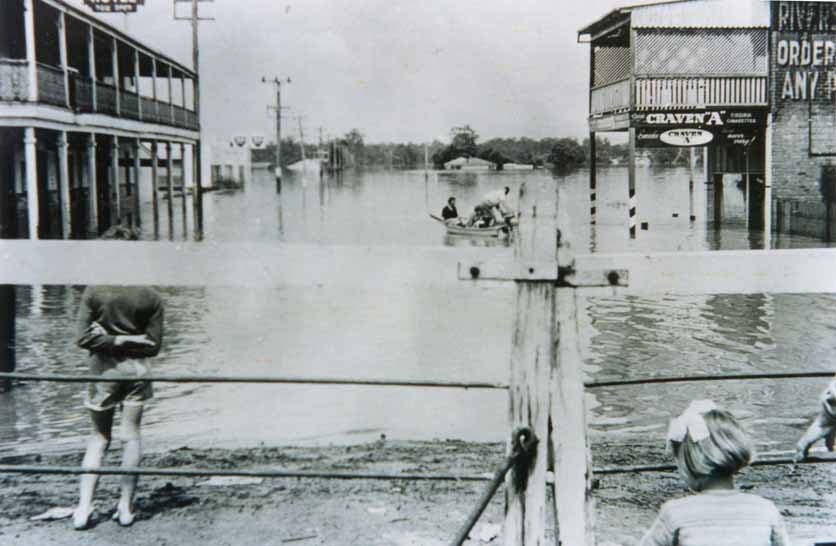
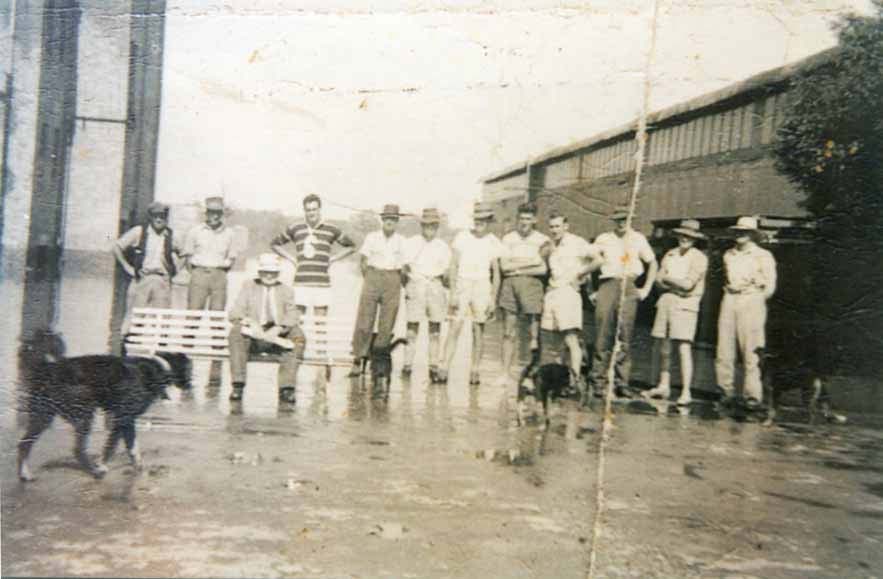
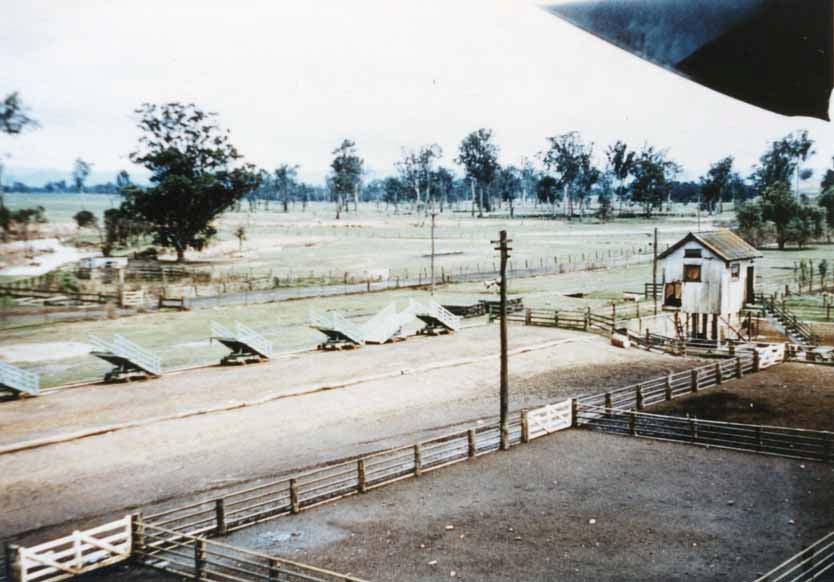
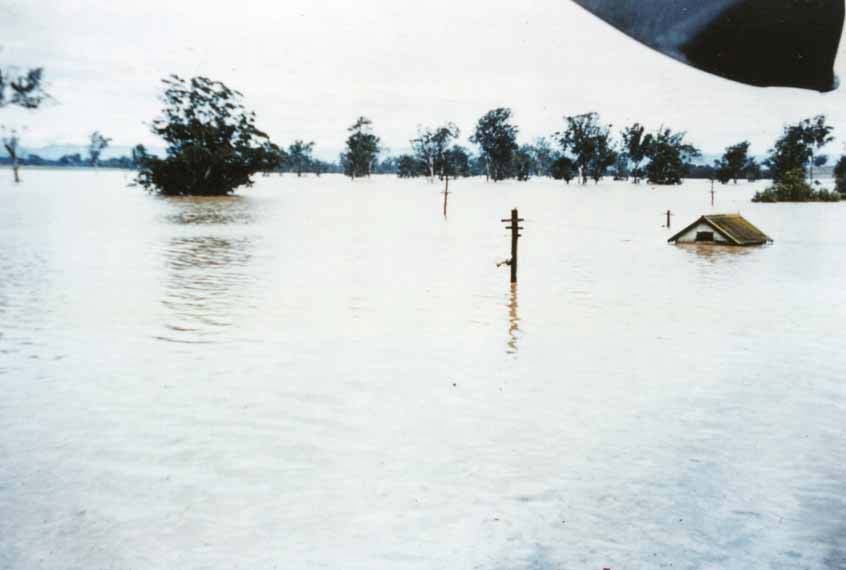 1961 Flood before (below) and after (above) photos (6 weeks apart) taken from the top of the old skin sheds looking over the stables behind the Riverstone Meatworks.
1961 Flood before (below) and after (above) photos (6 weeks apart) taken from the top of the old skin sheds looking over the stables behind the Riverstone Meatworks.
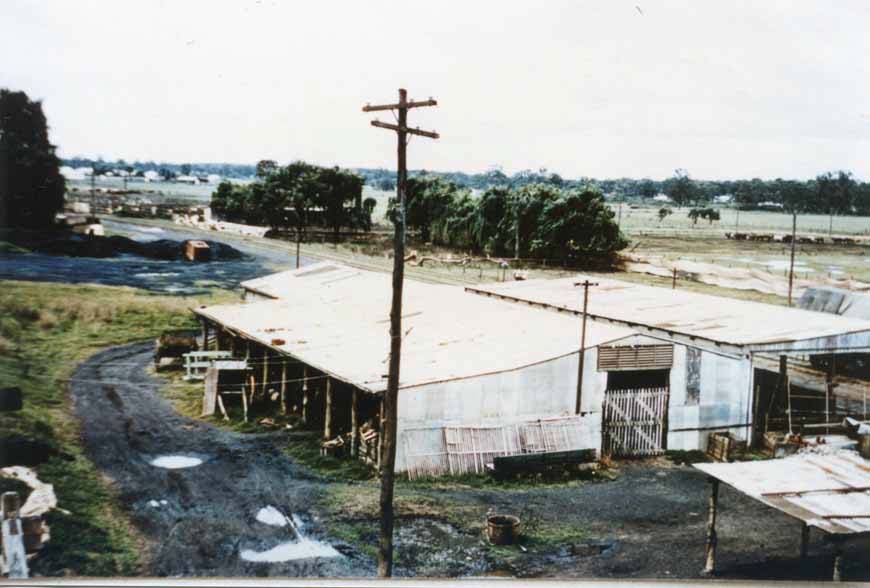
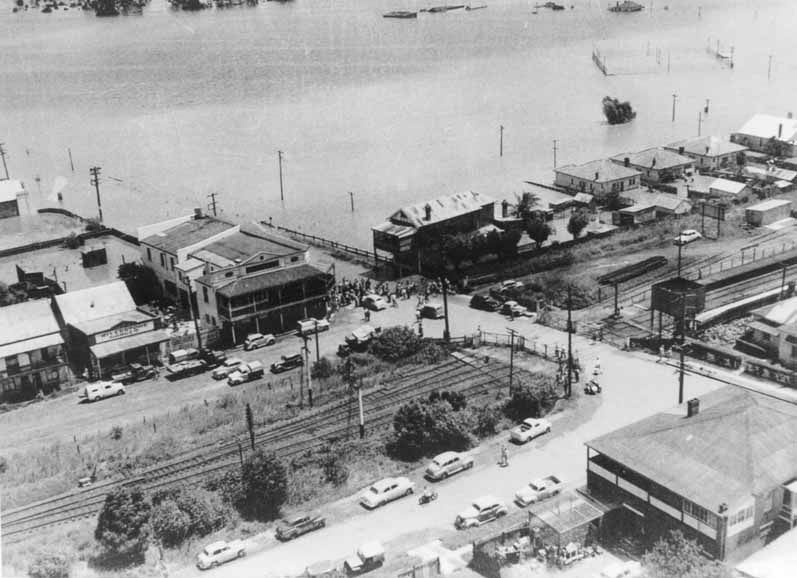
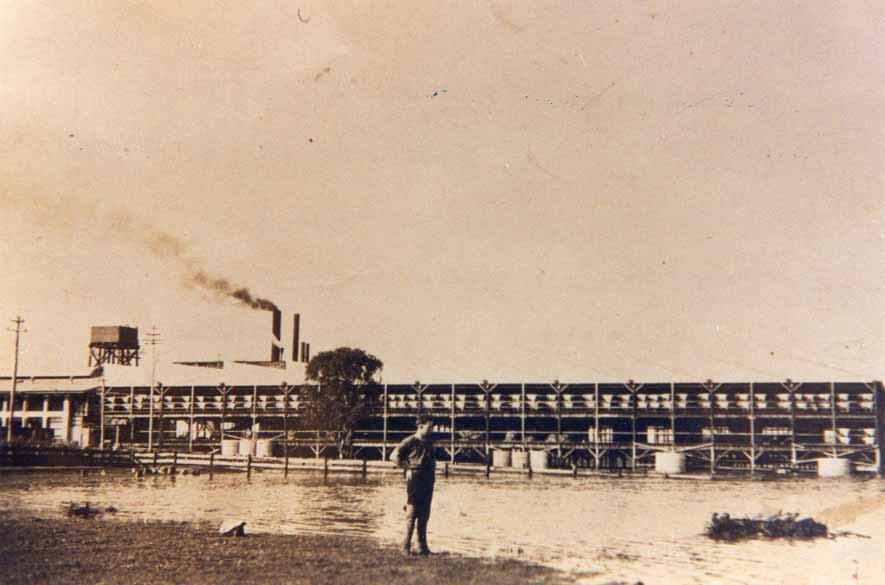
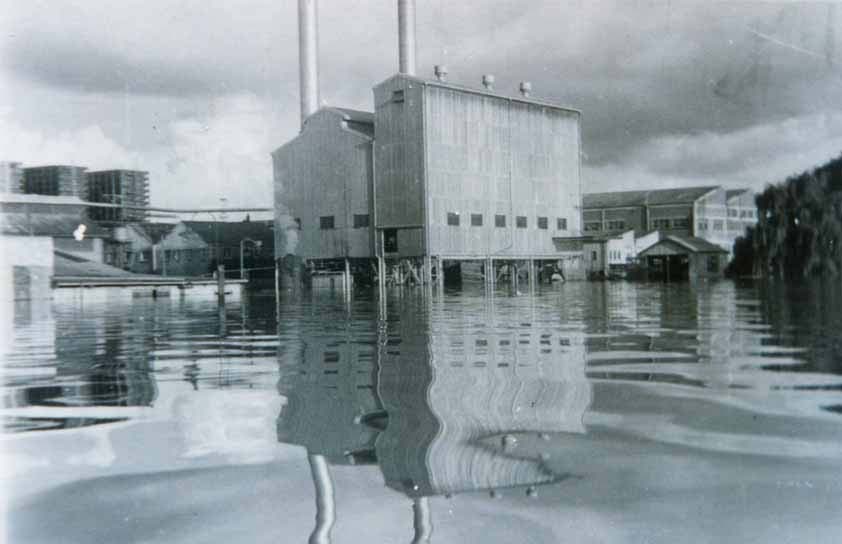
[courtesy of B. Allison].
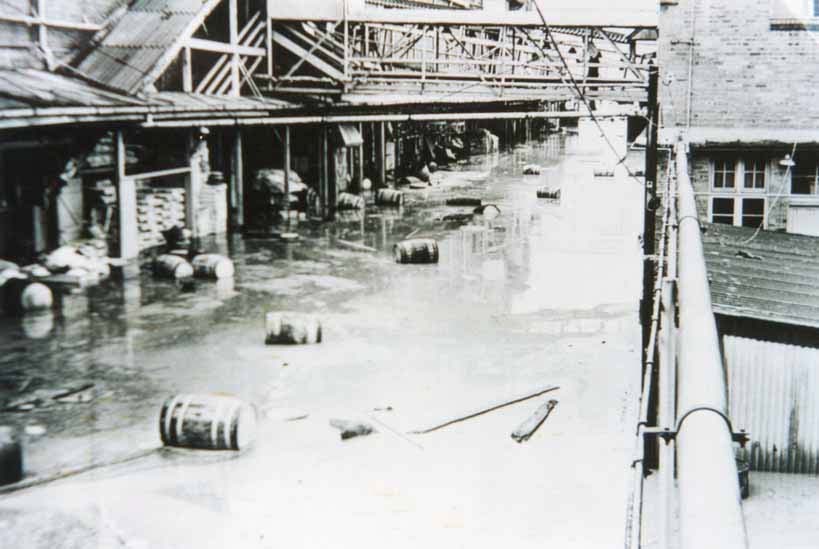
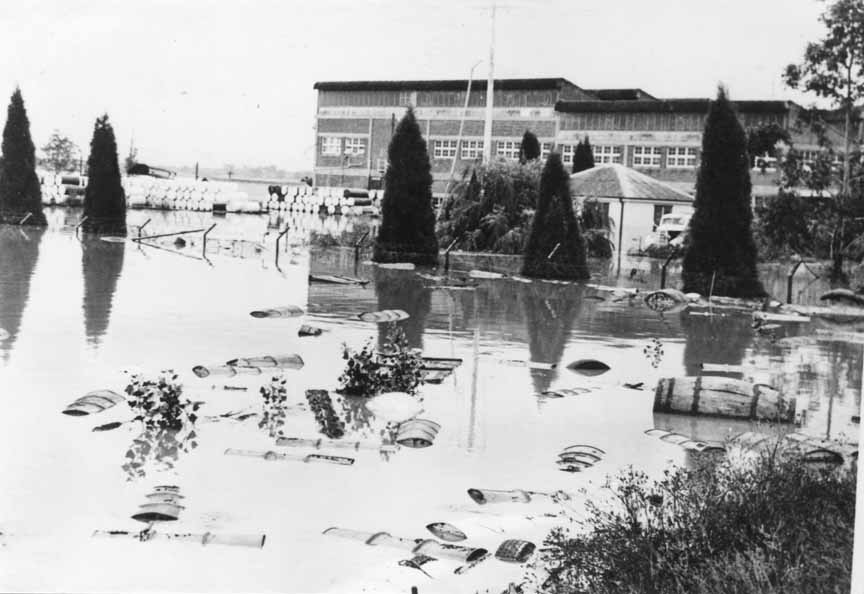
George Ireland and the “Riverstone Hotel”
by Ross & Shirley Seale
George Ireland, licensee of the “Riverstone Hotel” from 1883 -1892, was born in 1837 the son of John Ireland, a hotel keeper of Burwood.
In 1866 he married Agnes McCulloch, daughter of a notable Riverstone identity, at
Parramatta. His brother William, married Julia Ann Seale, daughter of Thomas Seale, also a hotel keeper of Burwood. Mary Ann Ireland married Agnes McCulloch’s brother.
The Seale, McCulloch and Ireland families were a close group and suffered adversity
together, as shown by a shared grave in May’s Hill Cemetery, which records the deaths of:
- Hylton Charles Seale died 18.3.1876, 16 days
- Melbourne Harry Seale died 28.8.1876, 16 months
- Robert John Ireland died 21.4.1881, 1 year
- Montague Nelson Ireland died 4.2.1885, 1 year
In the next plot are recorded the deaths of two McCullochs.
Mr and Mrs George Ireland took a great interest in the local community.
Mrs Ireland donated the font and “fair white linen” to the Anglican church of St Paul’s in
Riverstone and after the opening service in 1885, entertained the clergy and a number of friends “most hospitably” at the Riverstone Hotel.
The Hotel was also made available for community meetings such as that held in October 1889 to elect a permanent Progress Committee, and also in 1889 for 14 members from Riverstone already in the Mounted Infantry. Windsor & Richmond Gazette.
The Cumberland Mercury, Wednesday April 1, 1885 showed the following ads:
On 18th October 1889 the Gazette reported that Mr Ireland, as well as Messrs Wood,
Shepherd, Mitchell and Shouter are making their pile on the gold fields, having previously reported on l0th August of the same year that “Mr G. Ireland and W. Links are off gold mining at Christmas to Mount Morgan.”
Harrington McMaster Ireland, born 1874, was the first child of George Ireland. His
association with the district lasted long after his father relinquished the licence of “The
Riverstone Hotel”, as The Australian newspaper reports a contest that took place at “Mr Joseph’s Hotel” {the next licensee 1893 -1899) in April 1899, between Mr H. Ireland and Mr A. Buckley. Obviously a challenge match, it created much interest.
| “An exciting billiard match took place here last week … Mr Ireland played with a broom handle and Buckley with a cue. Ireland won by 2 points.” | |
| The Australian 21.4.1899 |
Harrington Ireland is shown in the 1901 Electoral Roll for Riverstone as a butcher, but he also raised race horses. His best known was “Major” which won at Rooty Hill in one event in February 1899, and placed second in another, presumably at the same meeting. He was then trained to run at Rosebery Park, where in March 1899 he was placed second, at long odds.
The Australian 12.2.1899 and 24.3.1899.

